Secure, Deliver and Optimize GenAI Apps with F5 Source | Edit on
Class 3: Architect, build and deploy AI Services¶

With the growing popularity of Generative AI, your organization has decided to upgrade the Arcadia trading platform by integrating a Generative AI (GenAI) chatbot. Below is the conceptual architecture of the AI Services setup.
Note
For Lab purposes, shared server will be used instead of a dedicated server for each components.
WebApps - K8S
- Arcadia Financial Modern apps
- Langchain (FlowiseAI)
- Vector DB (Qdrant)
- Simply-Chat (Simple GenAI Chatbot frontend)
AI Gateway - K8S
- AI Gateway Core
- Open WebUI
- Ollama Model Inference Service
- Model Repository
AI Processor - K8S
- AI Gateway Processor
Registry Linux Jumphost
- Harbor Registry server
- Linux Jumphost
1 - Conceptual Architecture of AI Services¶
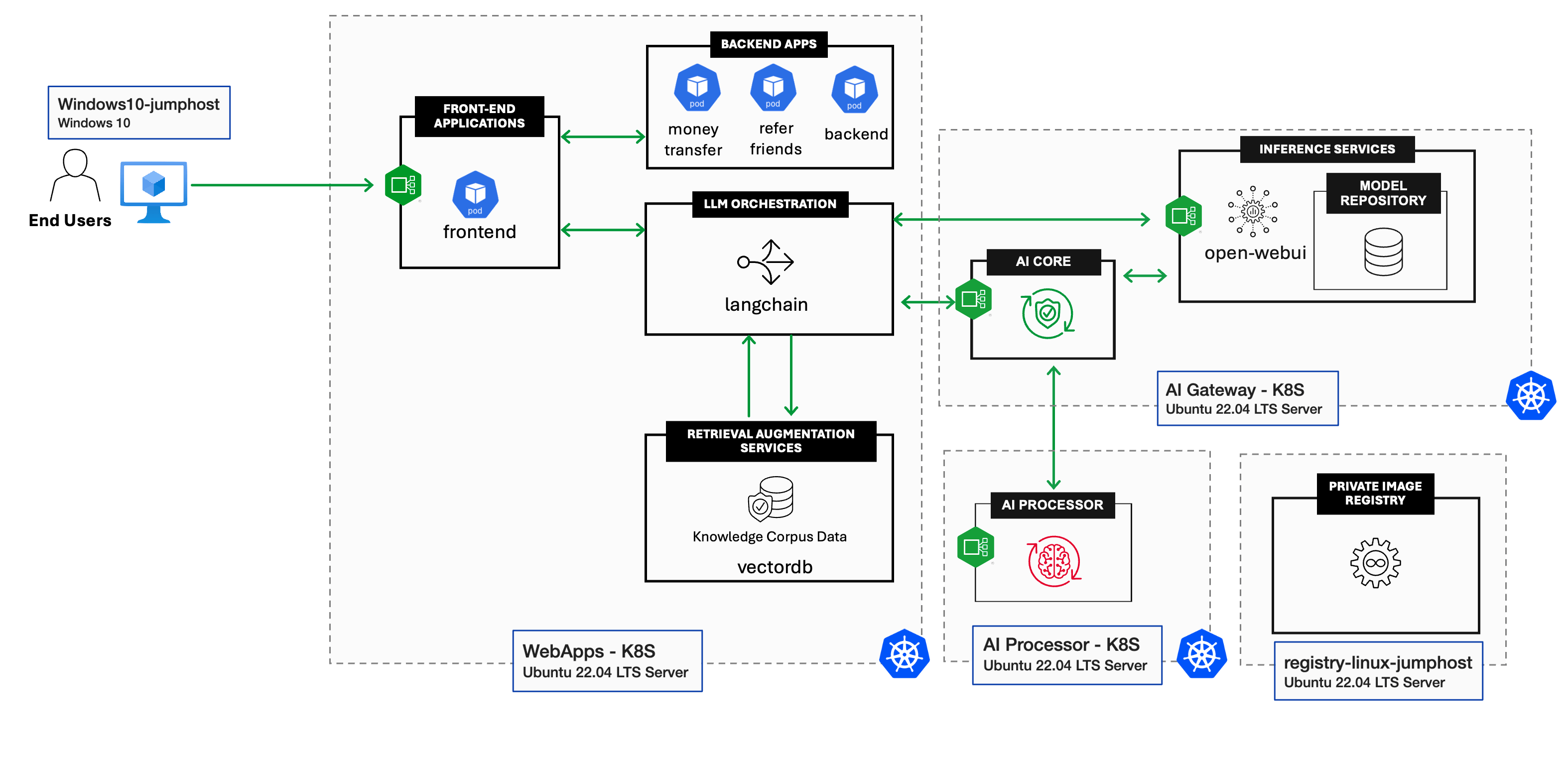
2 - Deploy Nginx Ingress Controller for AIGW K8S¶

cd ~/ai-gateway/nginx-ingress
kubectl create ns nginx-ingress
helm -n nginx-ingress install nginxic \
oci://ghcr.io/nginxinc/charts/nginx-ingress -f values.yaml --version 1.4.0
kubectl -n nginx-ingress get pod,svc
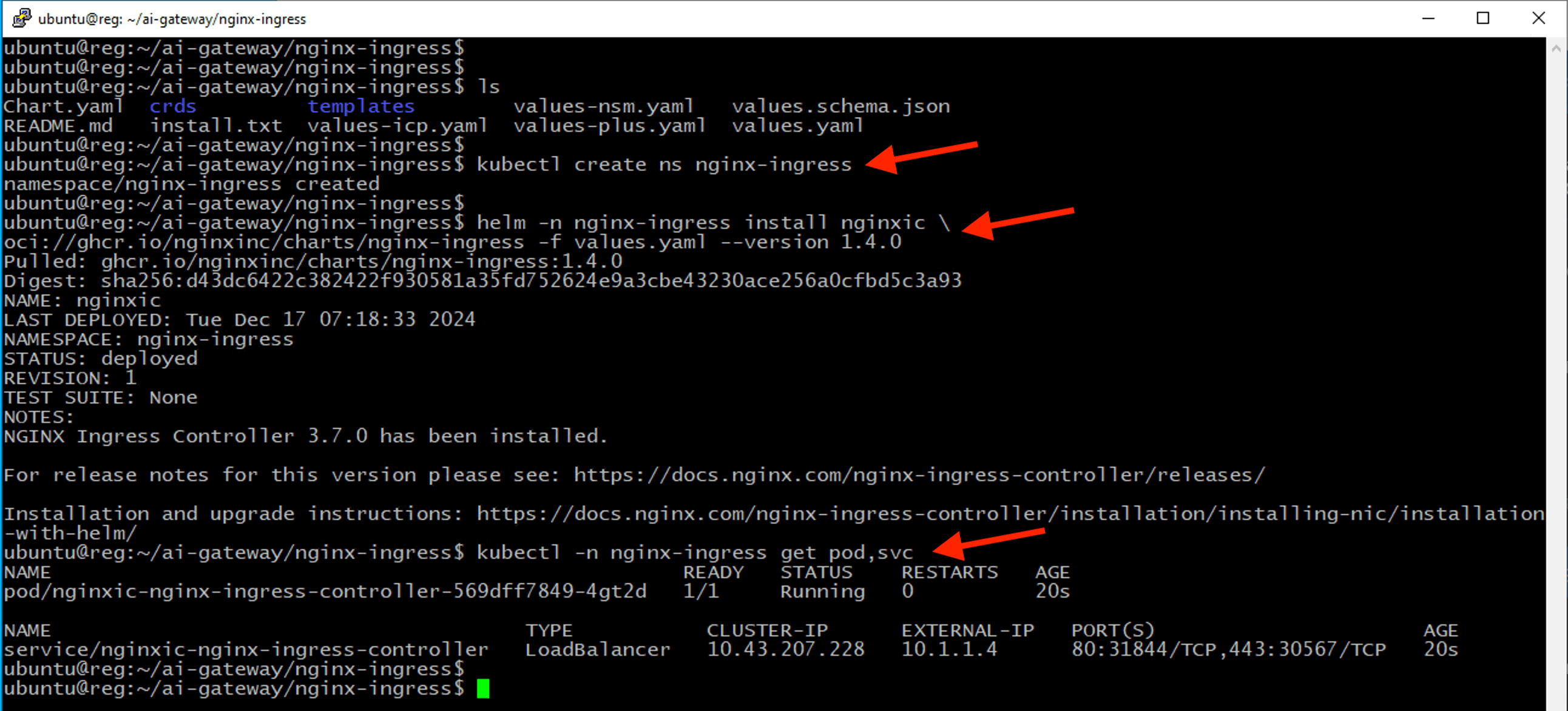
3 - Deploy Open-WebUI with Ollama Service¶
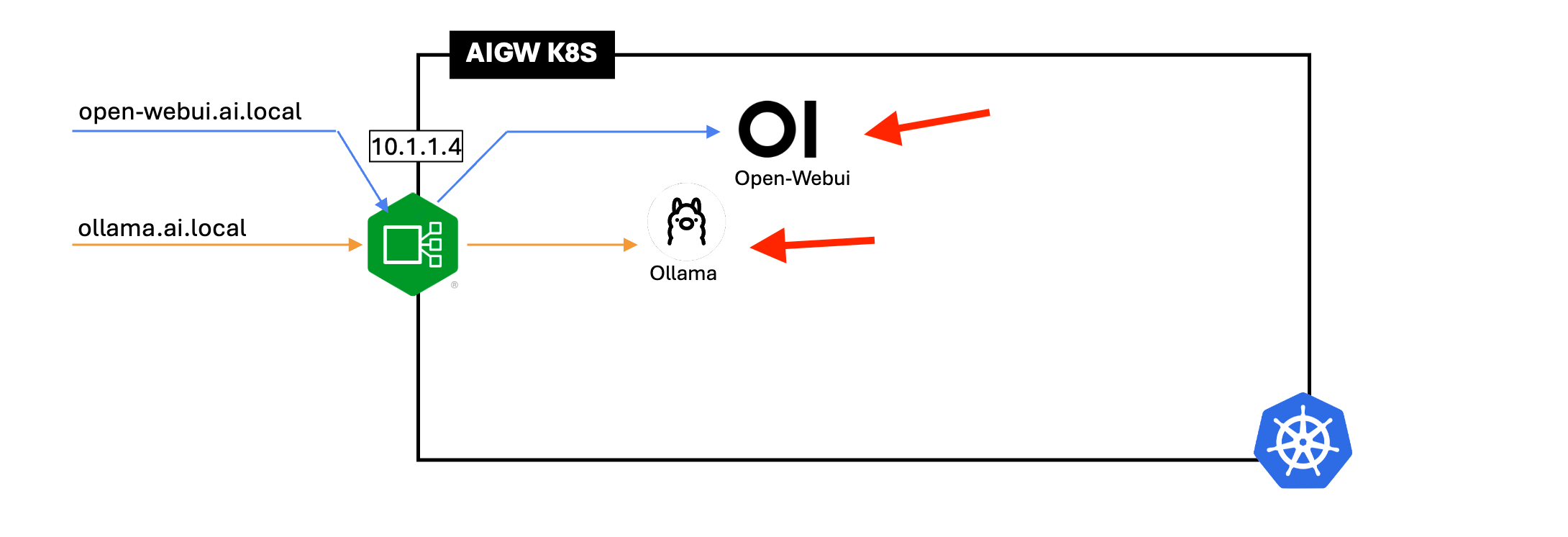
Open-Webui is a self-hosted WebUI that allow user to interact with AI models. It allow user to download respective language model that use by Ollama.
Ollama is a open-source tools that allow user to run large language model. User can expose model access via Ollama inference API.
cd ~/ai-gateway/open-webui-manifest
kubectl create ns open-webui
kubectl -n open-webui apply -k base
kubectl -n open-webui get pod,svc
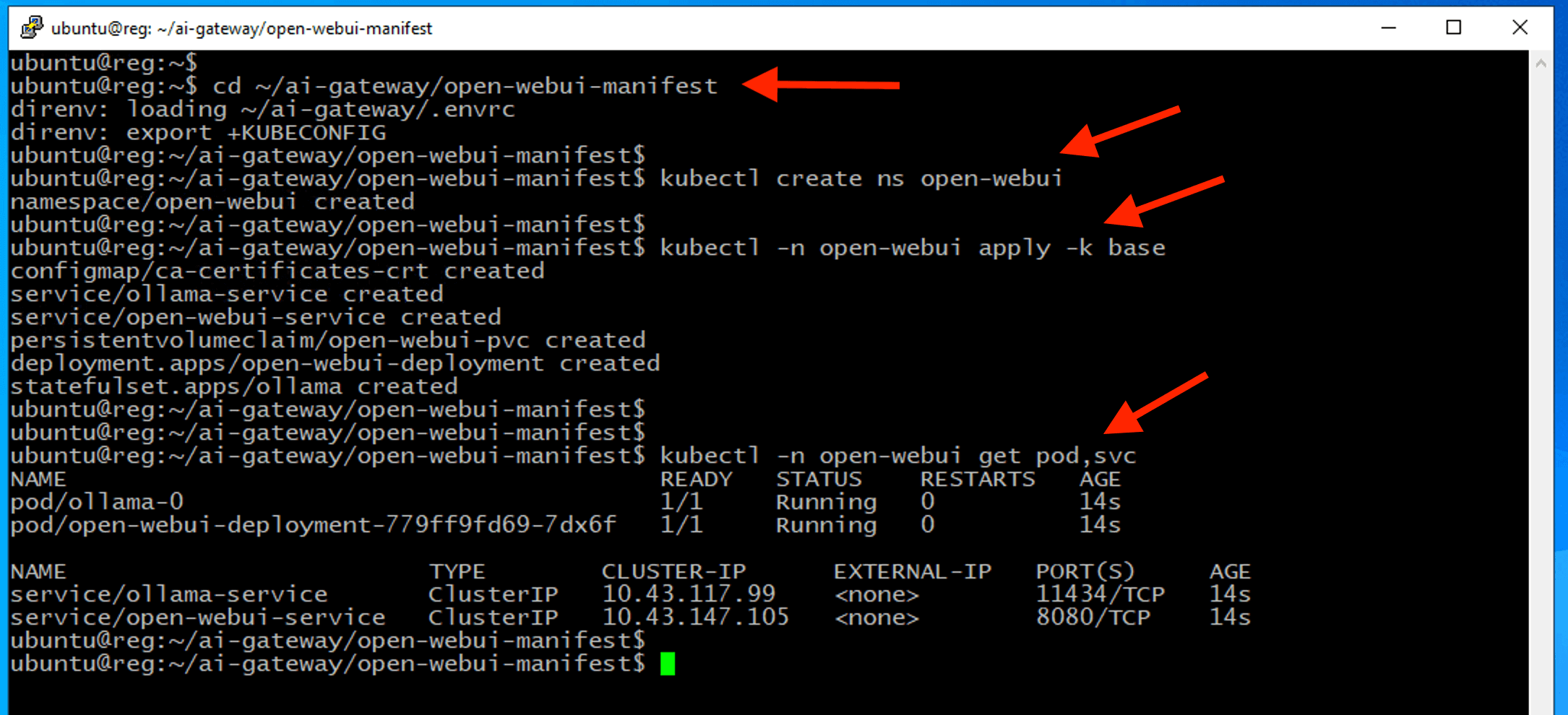
Note
Ensure all pods are in Running and READY state where all pods count ready before proceed.
Create an Nginx ingress resource to expose the Open-WebUI service externally from the Kubernetes cluster.
Note
We also create ingress for Ollama. We leverage mergable ingress resource for Nginx as we will need cross namespace access.
cd ~/ai-gateway/nginx-ingress-open-webui/
ls -l
kubectl -n open-webui apply -f open-webui-ingress-https.yaml
kubectl -n open-webui apply -f ollama-ingress-http.yaml
kubectl -n open-webui apply -f open-webui-ingress-ollama-minion.yaml
kubectl -n open-webui get ingress
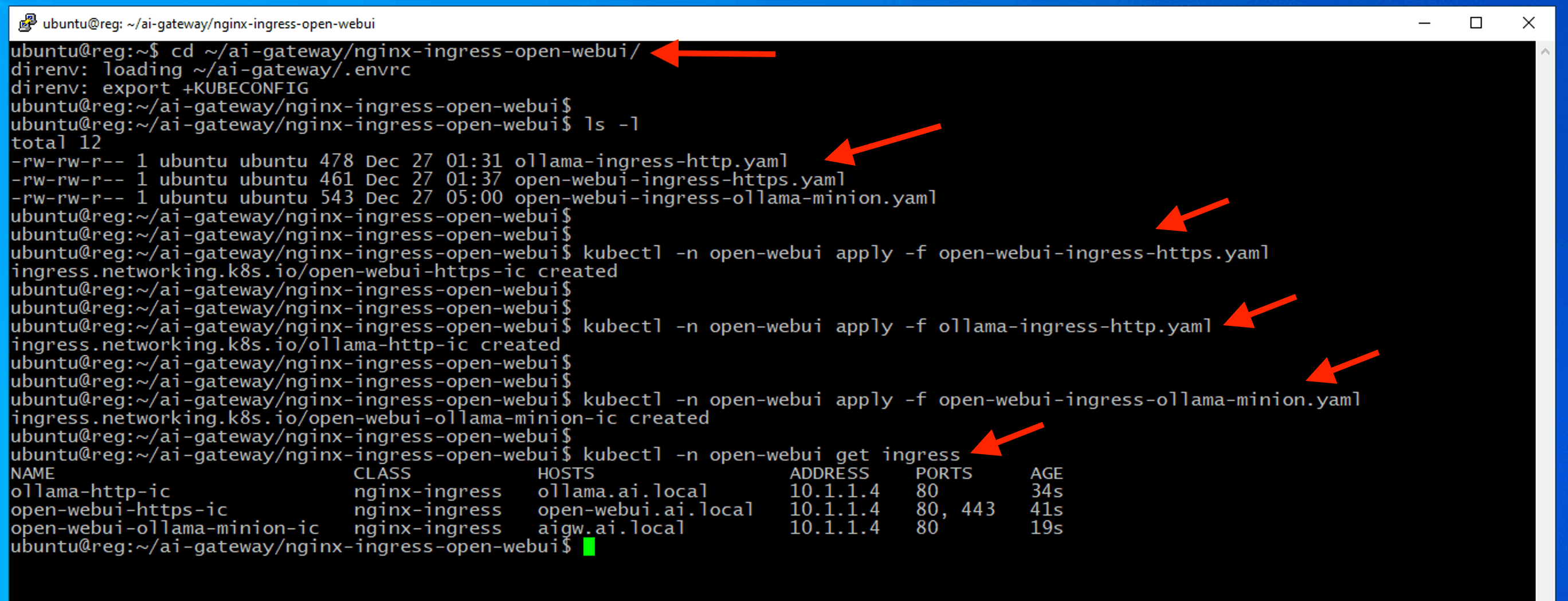
Note
Feel free to explore the content of those ingress resource to understand how those services being exposed.
From Chrome browser, confirm you can access to Open-Webui service.
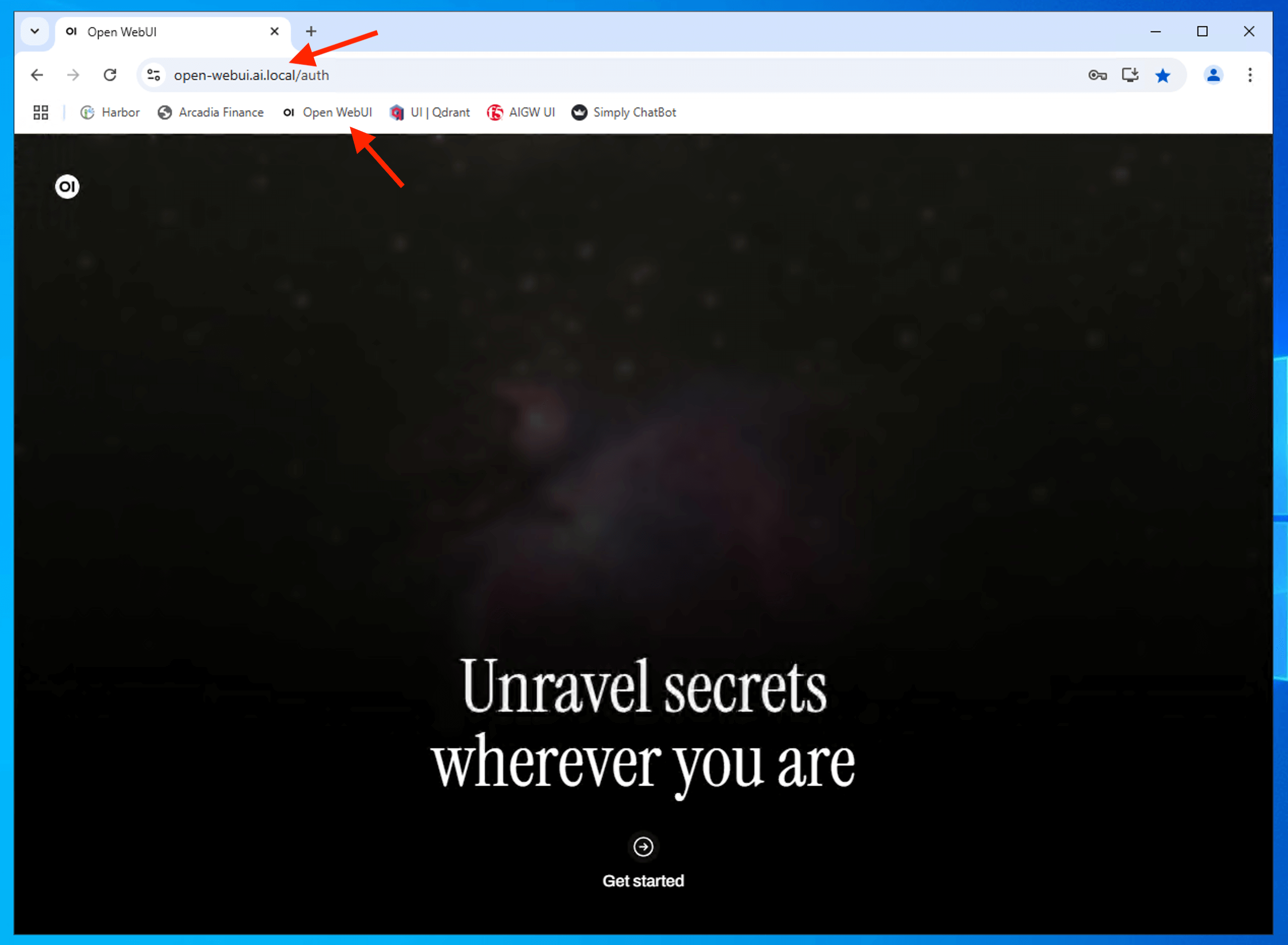
First time sign up a new user (any abitary name). Make sure you remember or use the suggested name
| Name | F5 AI |
| f5ai@f5.com | |
| Password | F5Passw0rd |
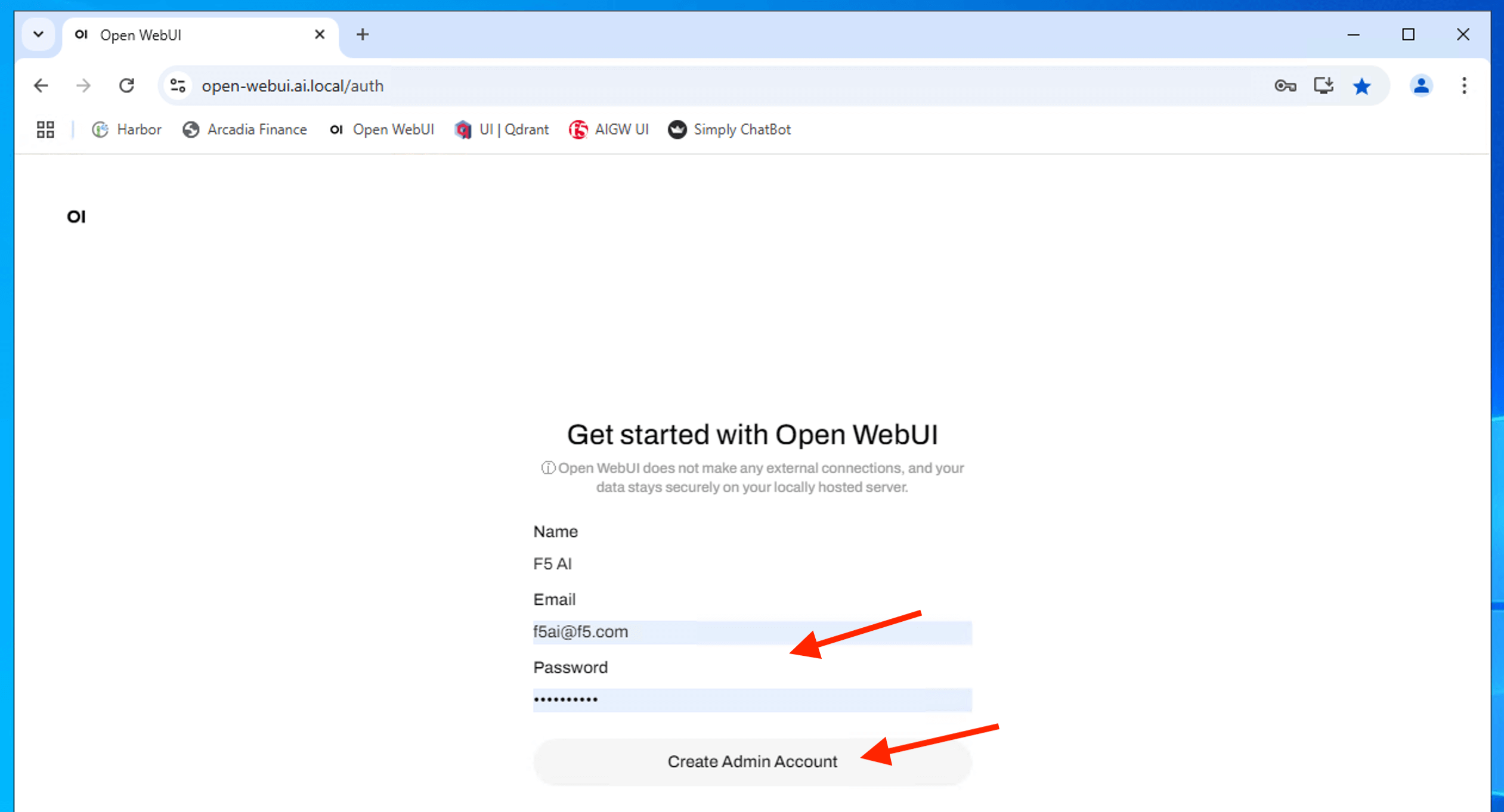
Successfully signup and login to Open-WebUI
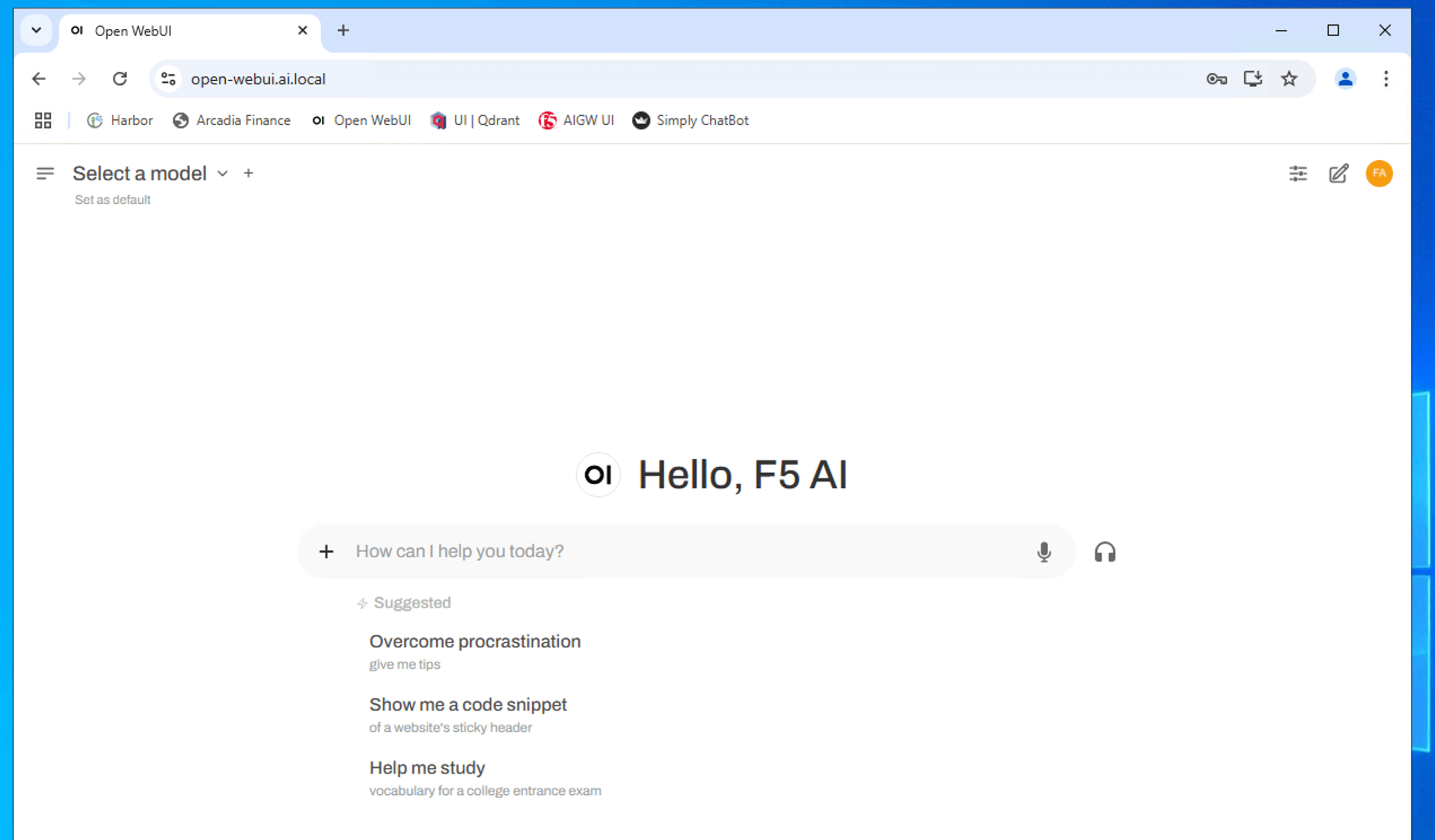
4 - Download Language Model¶
From Open WebUI, type the model name onto the search button and hover mouse to the click “Pull “xxxxxx” from Ollama.com” to pull the model down and host it locally.
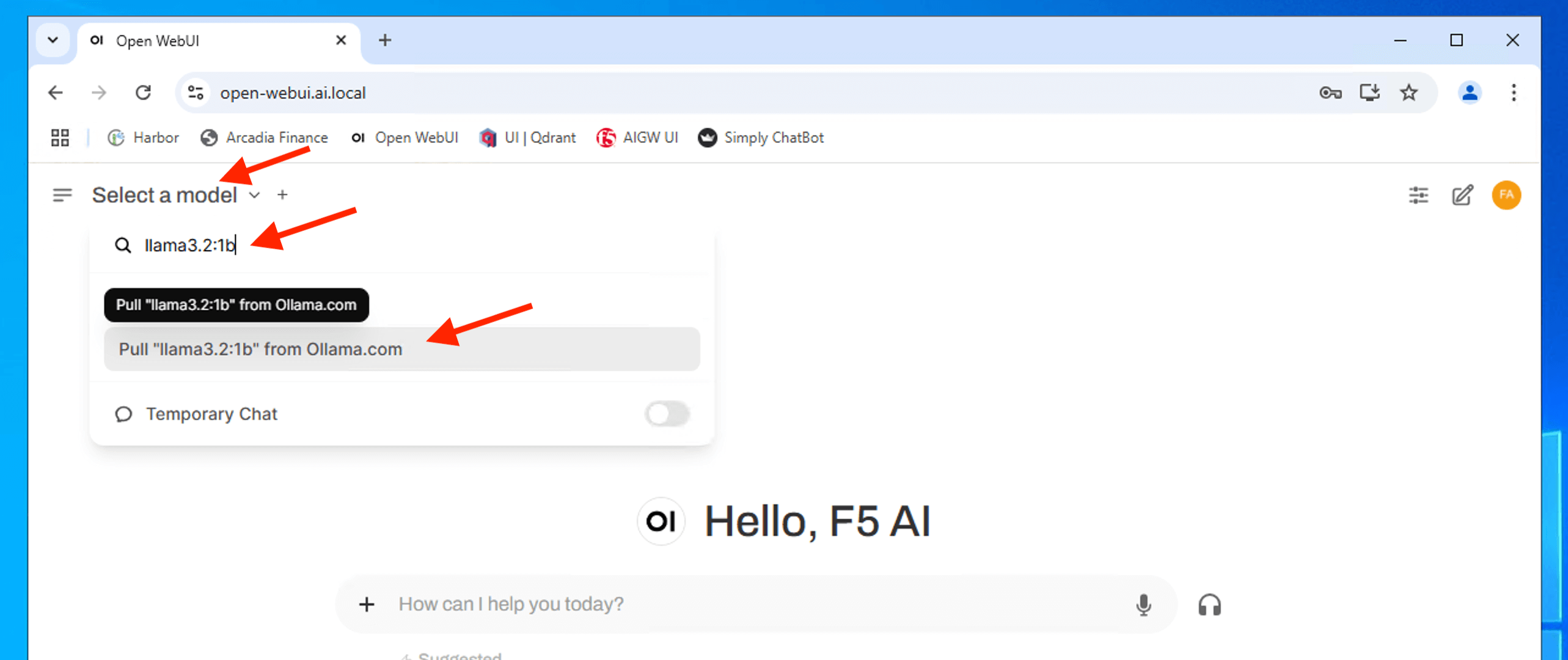

Repeat the above to download the following LLM model
| Model | Name |
|---|---|
| phi3 | Microsoft (3.8b) |
| phi3.5 | Microsoft (3.8b) |
| llama3.2:1b | Meta Llama3.2 (1b) |
| qwen2.5:1.5b | Alibaba Cloud Qwen2 (1.5b) |
| hangyang/rakutenai-7b-chat | Rakuten AI (7b) |
| nomic-embed-text | Open embedding model |
| codellama:7b | Meta generating and discuss code |
Ensure you have all the model downloaded before you proceed.
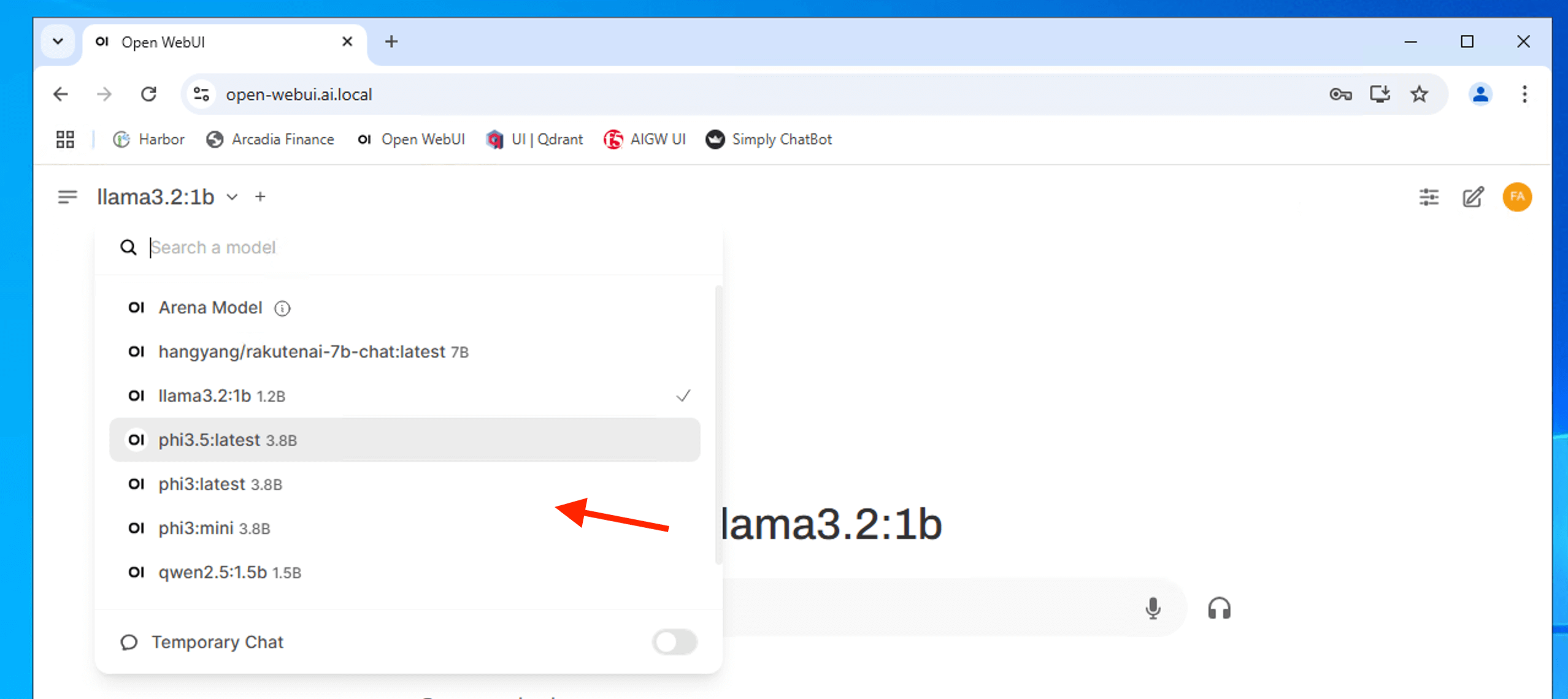
Test interacting with LLM model. Feel free to test with different language model.
多么美好的一天
素晴らしい一日でした
เป็นวันที่ยอดเยี่ยมจริงๆ
hari yang indah sekali
Attention
Please do note that UDF environment were setup with CPU (no GPU). Hence, all model inference will run on CPU instead of GPU. Performance may not be optimum but should be acceptable for lab. Please be patience as it depends on CPU consumption at that time of inference. First inference of the model may be slow and should be alright after that.
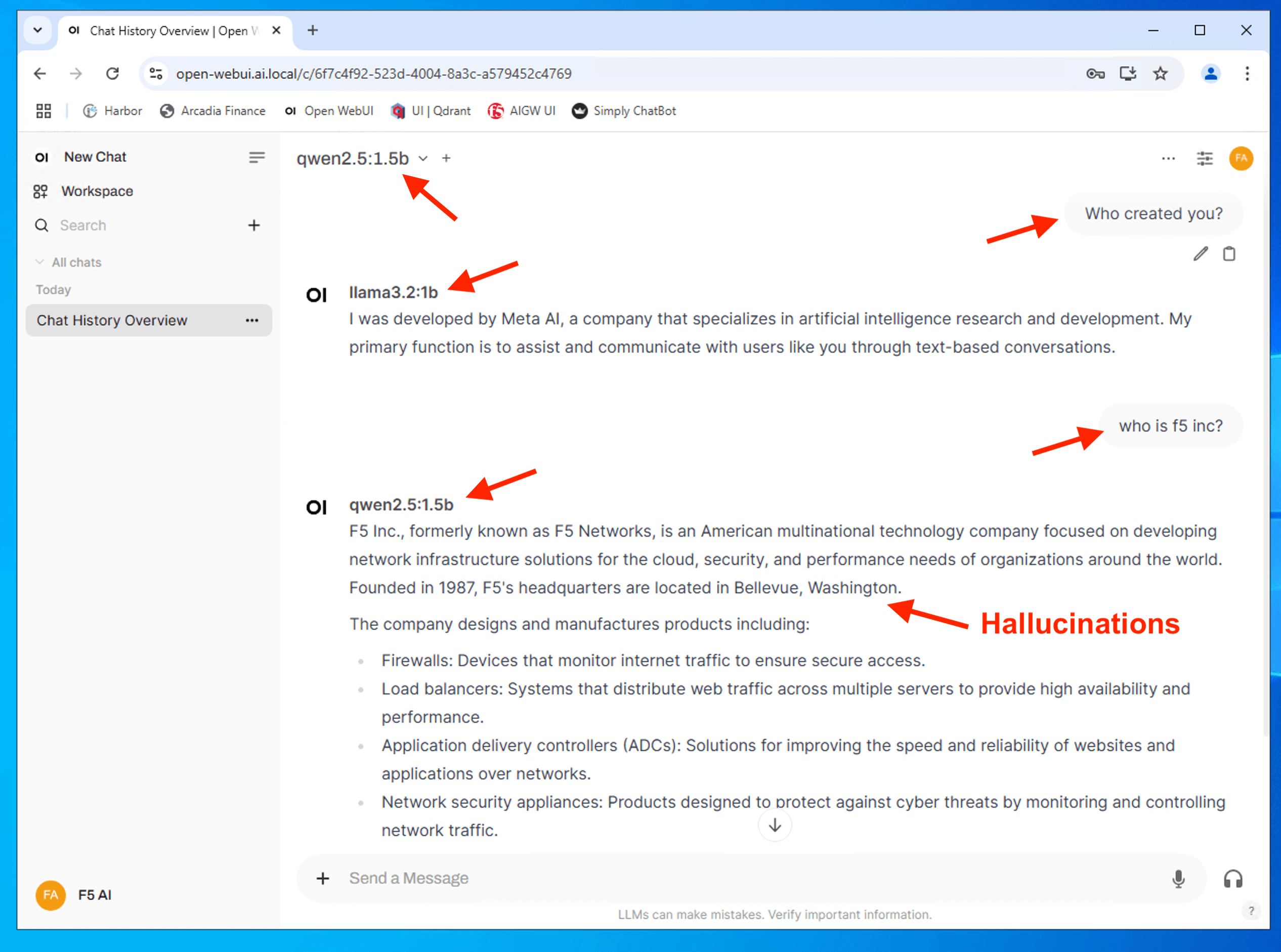
Attention
Please do notes that GenAI is hallucinating and providing wrong information - about F5 Inc headquarters. Please ignore as smaller model (smaller parameter, less intelligent) tend to hallucinate more compare to a larger model. Large models with more parameters are more capable and intelligent than smaller models, but require expensive machines with multiple GPUs to run.
It also depends on dataset use for the training - “Garbage In, Garbage Out”.
5 - Deploy LLM model service (Ollama)¶
Ollama API being exposed from previous step (step 3 above) when we ran “kubectl -n open-webui apply -f ollama-ingress-http.yaml” command.
Note
The Ollama API is currently exposed over HTTP instead of HTTPS. This is due to a limitation in the LLM orchestrator (FlowiseAI), which does not natively support self-signed certificates without some environment changes. To simplify the setup and eliminate resources consumption for encryption/decryption so that more CPU can be dedicated for inference, HTTP is used instead of HTTPS. However, all communication between the LLM orchestrator and other AI components occurs internally, within a controlled environment. For production deployment, ensure those communication are secure and encrypted. For FlowiseAI, you can define environment variable to ignore certificate verification. Please refer to official documentation.
Ollama API is the model serving endpoint. Since we are running inference from CPU, it will take a while for ollama to response to user. To ensure connections is not timeout on NGINX ingress, we need to increase the timeout on NGINX ingress for ollama. This nginx ingress resource for ollama had been deployed in step 3 above.
ollama-ingress-http.yaml
apiVersion: networking.k8s.io/v1
kind: Ingress
metadata:
name: ollama-http-ic
annotations:
nginx.org/proxy-connect-timeout: "120s"
nginx.org/proxy-read-timeout: "120s"
nginx.org/proxy-send-timeout: "120s"
spec:
ingressClassName: nginx-ingress
rules:
- host: ollama.ai.local
http:
paths:
- path: /
pathType: Prefix
backend:
service:
name: open-webui-ollama
port:
number: 11434
6 - Deploy LLM orchestrator service (Flowise AI)¶
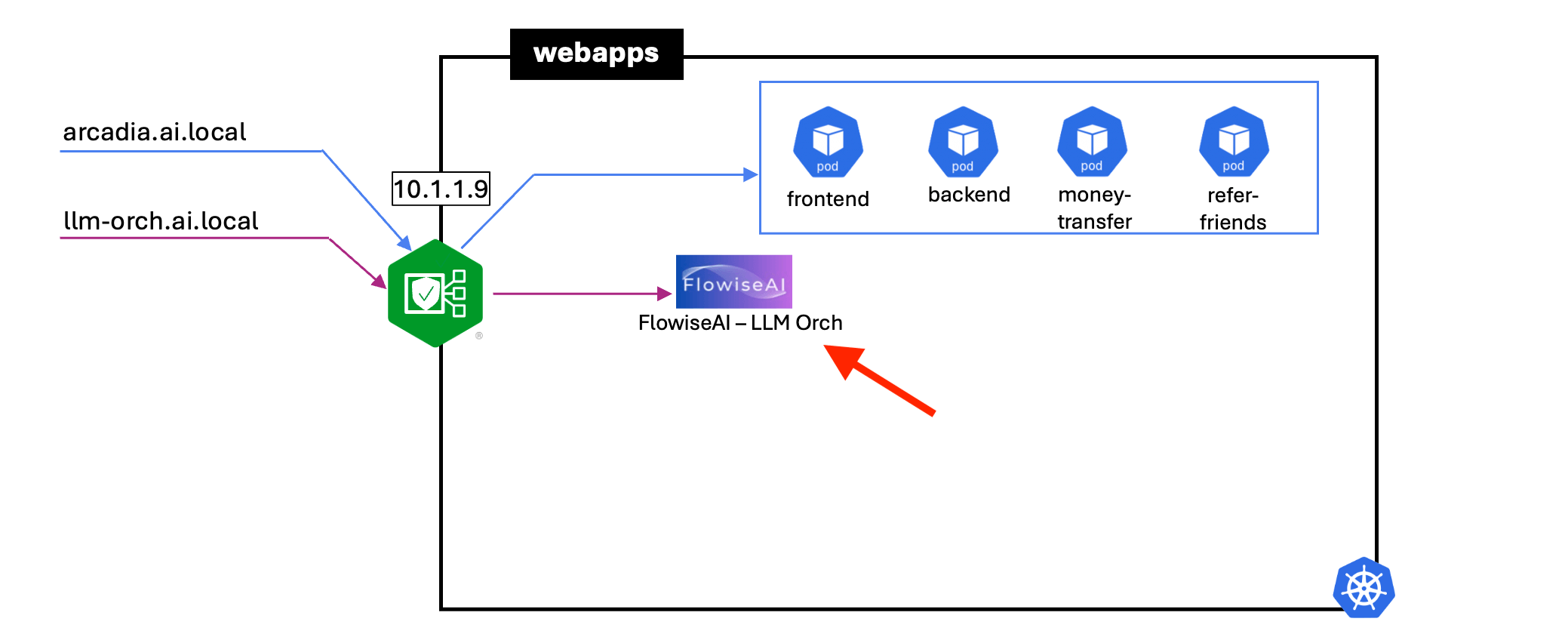
Deploy LLM Orchstrator to facilitate AI component communication. Flowise AI - an open source low-code tool for developer to build customized LLM orchstration flow and AI agent is used. (https://flowiseai.com/). Flowise complements LangChain by offering a visual interface.
cd ~/webapps/
ls
cd ~/webapps/flowiseai
helm repo add cowboysysop https://cowboysysop.github.io/charts/
kubectl create ns flowiseai
helm -n flowiseai install flowiseai --values values.yaml cowboysysop/flowise
kubectl -n flowiseai get po,svc
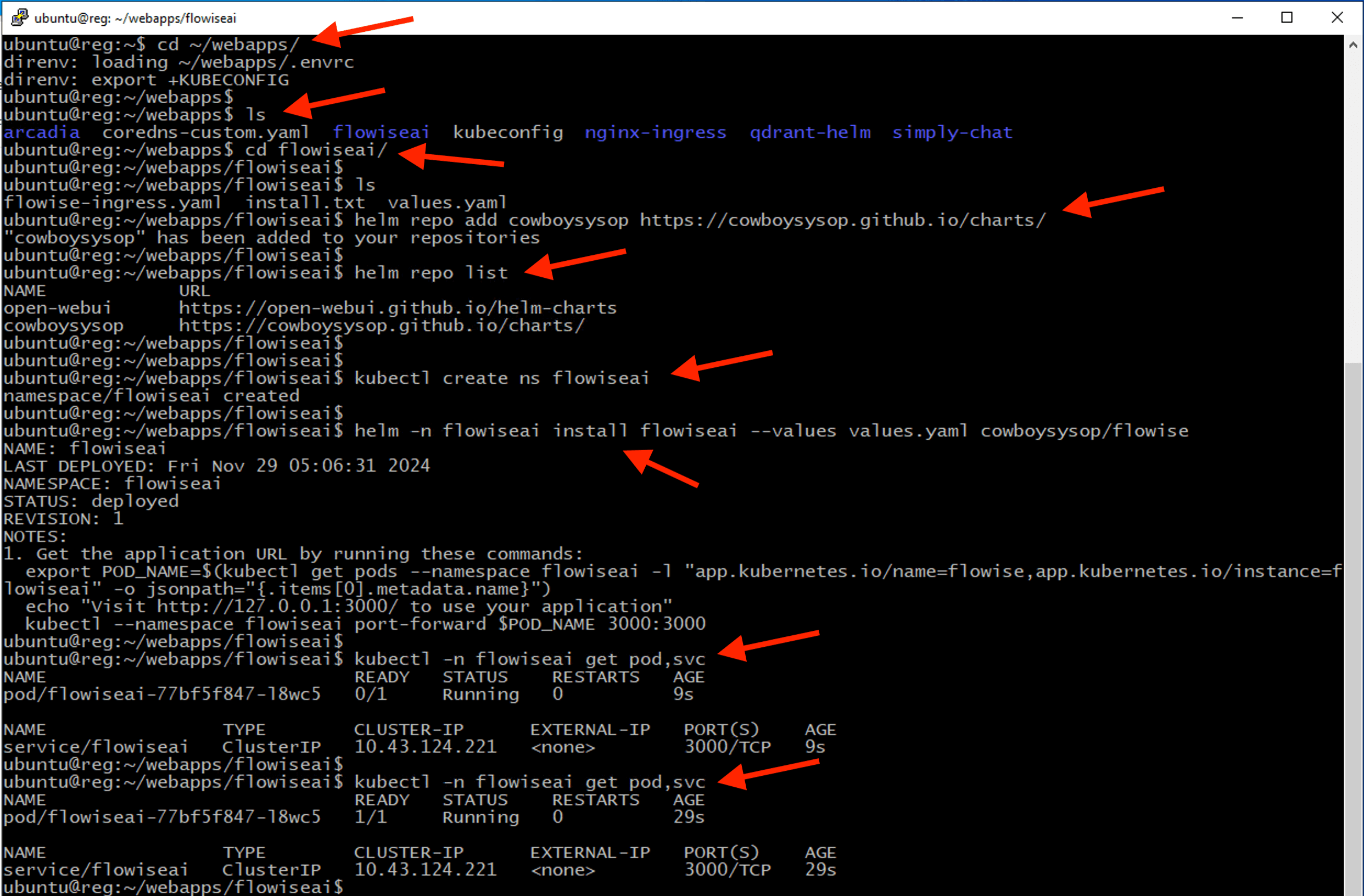
Flowise is installed with the following custom values. Plese take notes of the password as you may need it for the next section.
values.yaml
image:
registry: reg.ai.local
repository: flowiseai/flowise
tag: 2.2.3
serviceAccount:
create: true
resources:
limits:
cpu: 4000m
memory: 8Gi
requests:
cpu: 4000m
memory: 8Gi
persistence:
enabled: true
size: 5Gi
config:
username: "admin"
password: "F5Passw0rd"
extraEnvVars:
- name: LOG_LEVEL
value: 'info'
- name: DEBUG
value: 'false'
- name: NODE_TLS_REJECT_UNAUTHORIZED
value: '0'
Create an Nginx ingress resource to expose FlowiseAI/Langchain service externally from the Kubernetes cluster.
kubectl -n flowiseai apply -f flowise-ingress.yaml
kubectl -n flowiseai get ingress

Confirm that you can login and access to LLM orchestrator (flowise)
Attention
If no login prompt as shown below, likely credential was cache in the browser during the building phase of the lab. You can either do a clear browser cache or safely ignore if it doesn’t ask for password.
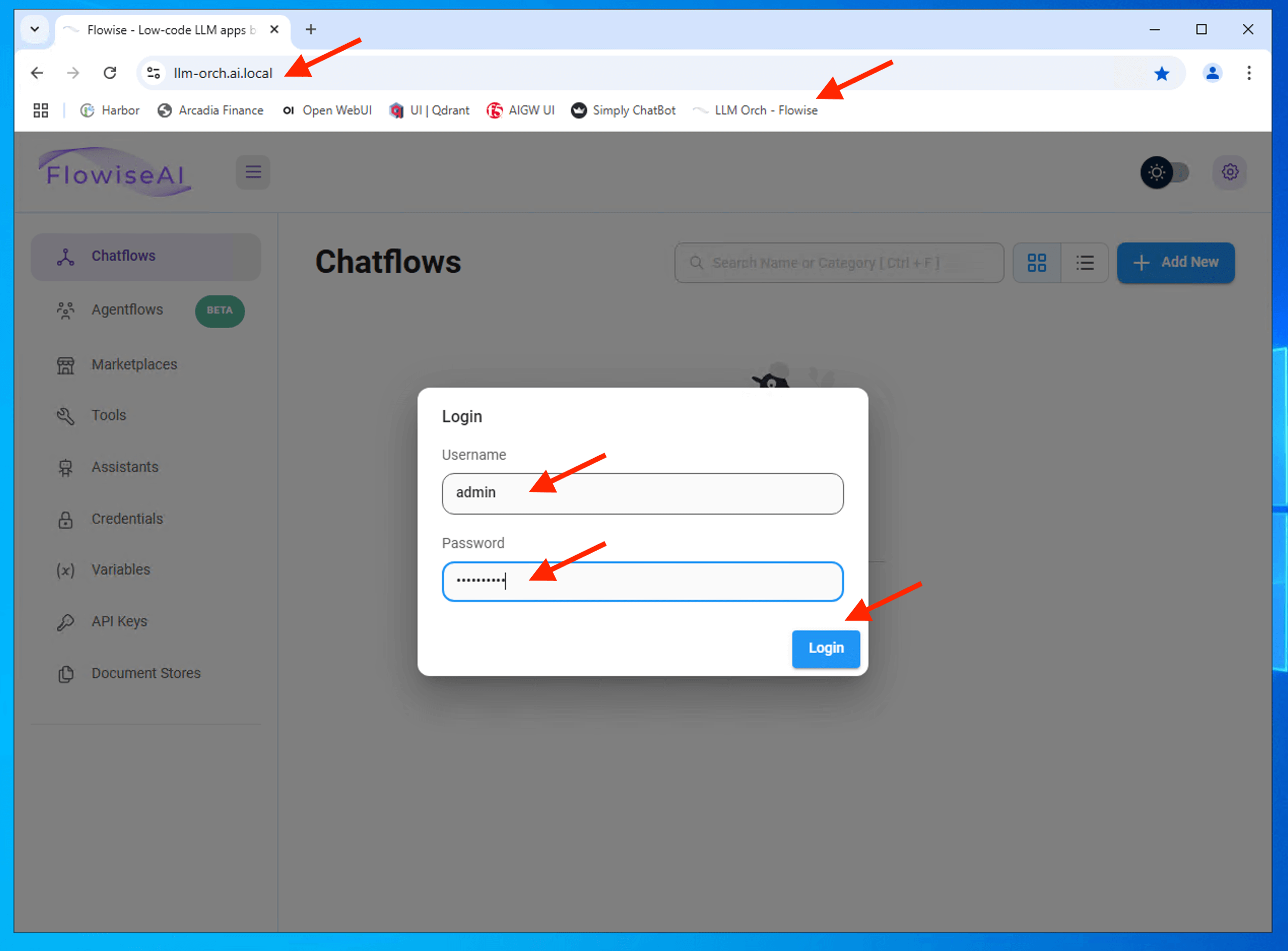
Import arcadia RAG chatflow into flowise. Select Add New, click Settings icons and Load Chatflow
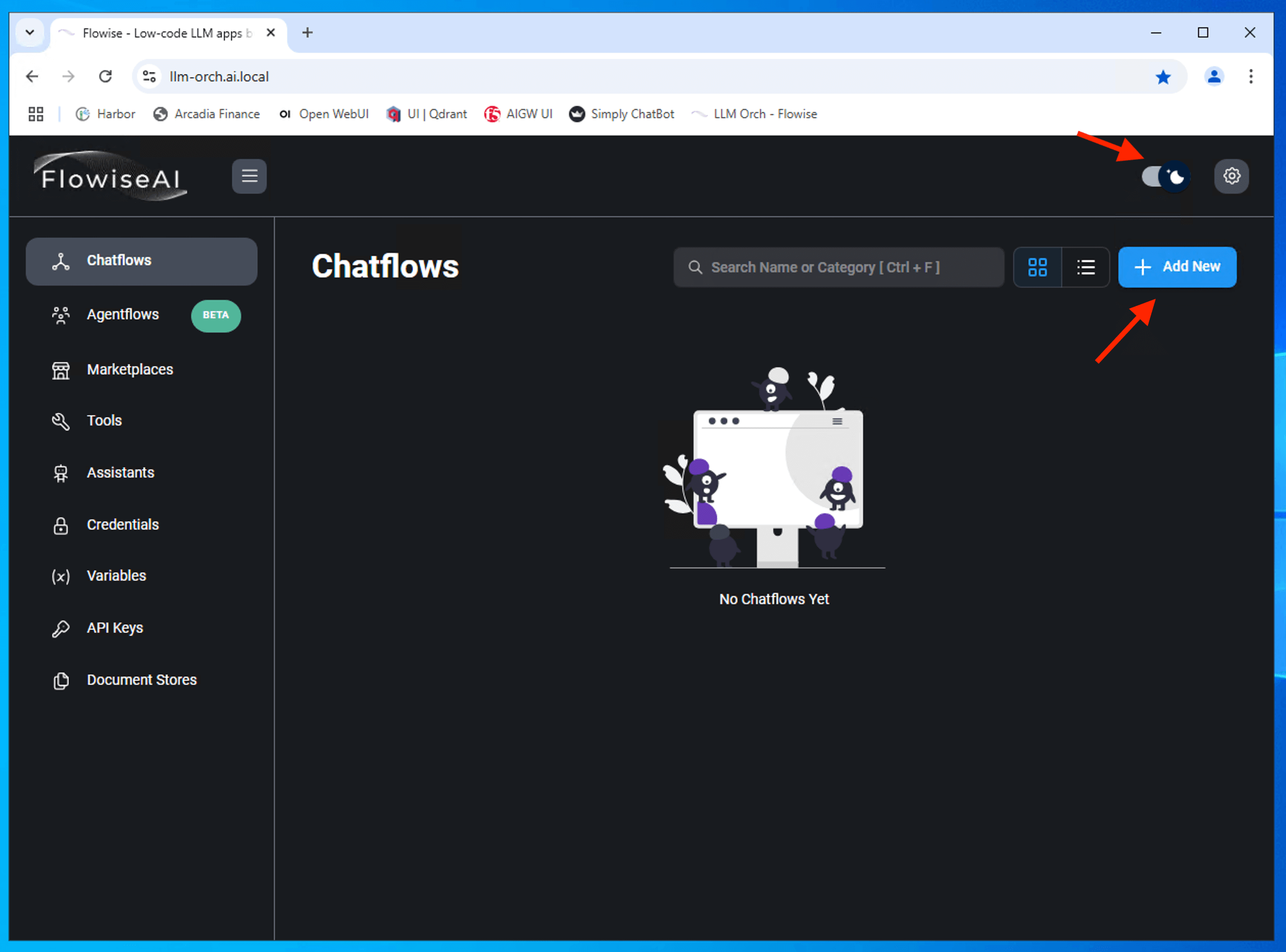
A copy of the chatflow located on the jumphost Documents directory. Select the chatflow json file.
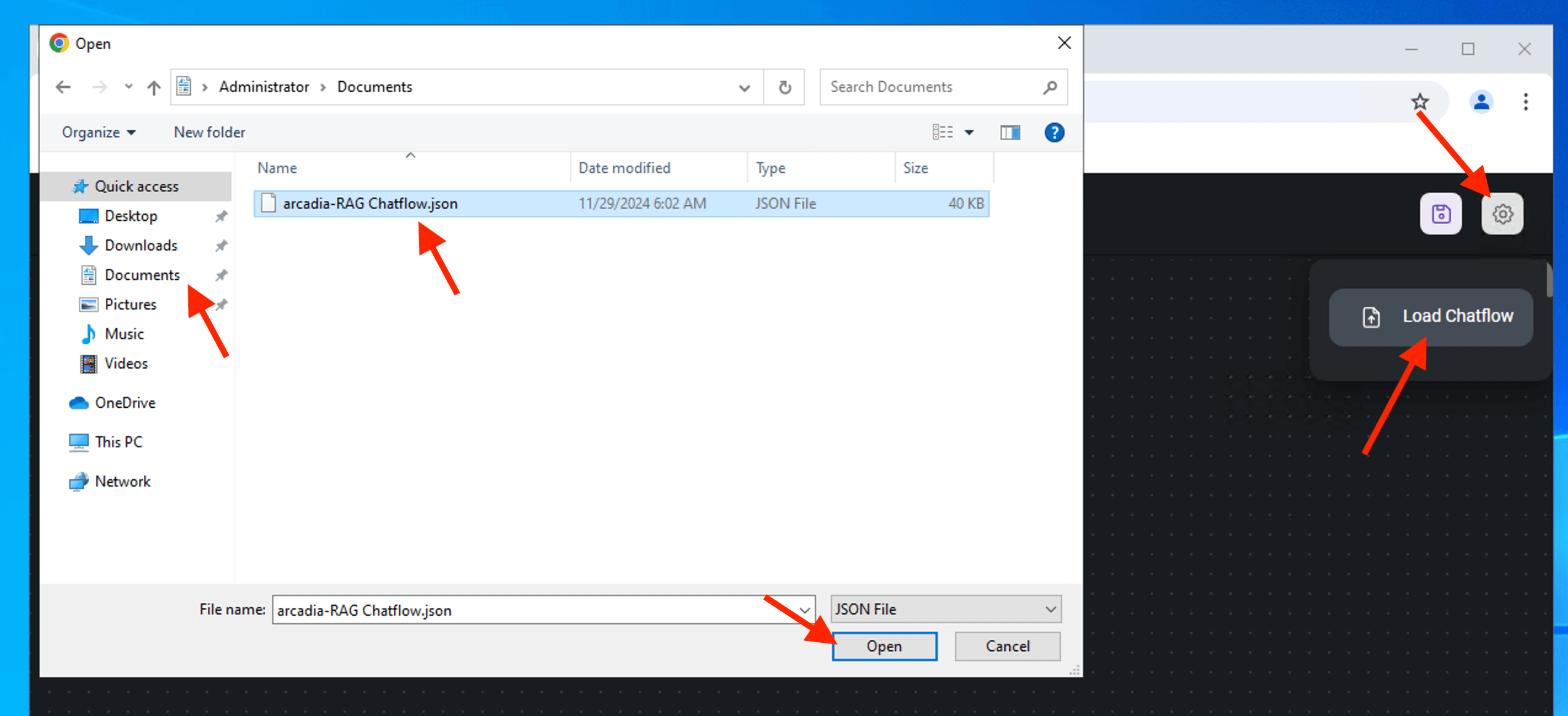
Save the chatflow (arcadia-rag)
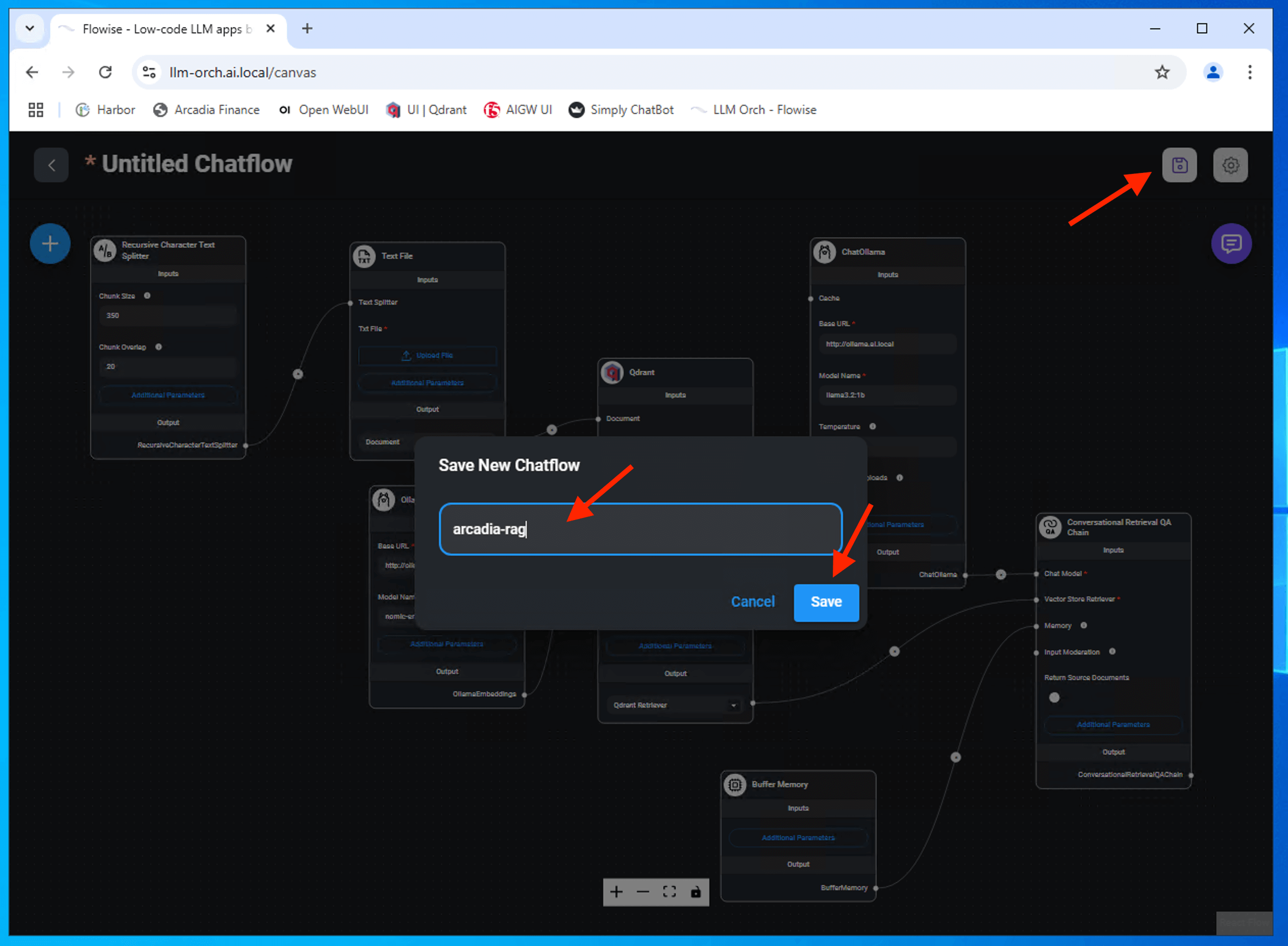
To successfully build the full langchain pipeline / chatflow, you need to upload organization context information into the RAG pipeline. Arcadia context information file located in the Documents directory. Under Text File node, Click Upload File
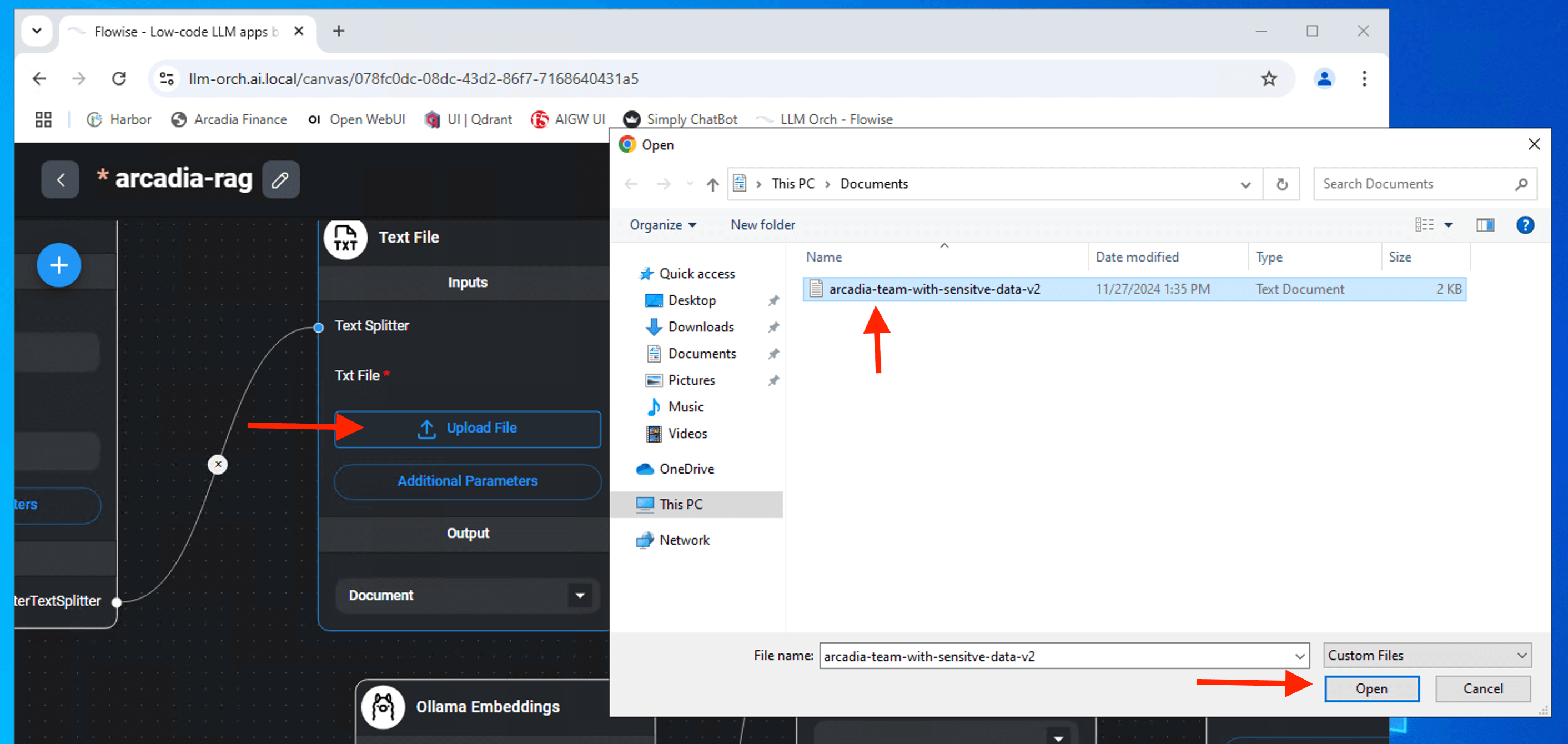
Save the chatflow with a name as shown.
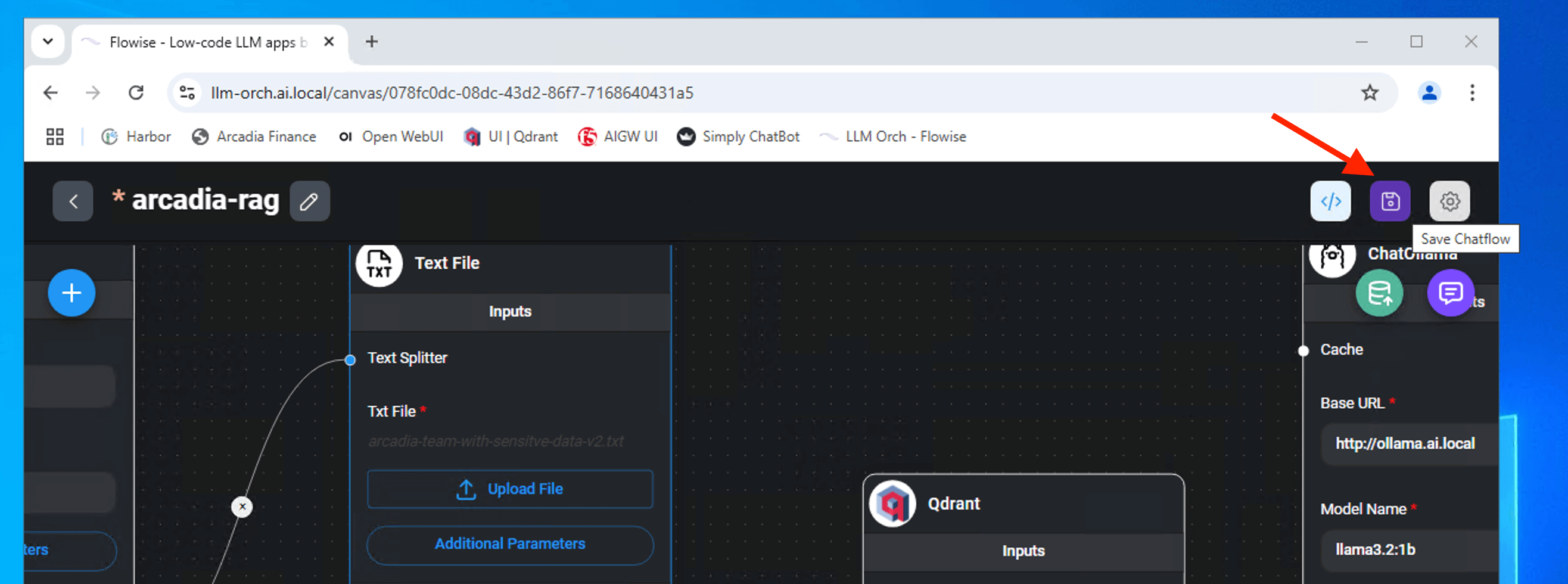
Note
We will return and continue to build RAG pipeline after we deploy vector database.
7 - Deploy Vector Database (Qdrant)¶
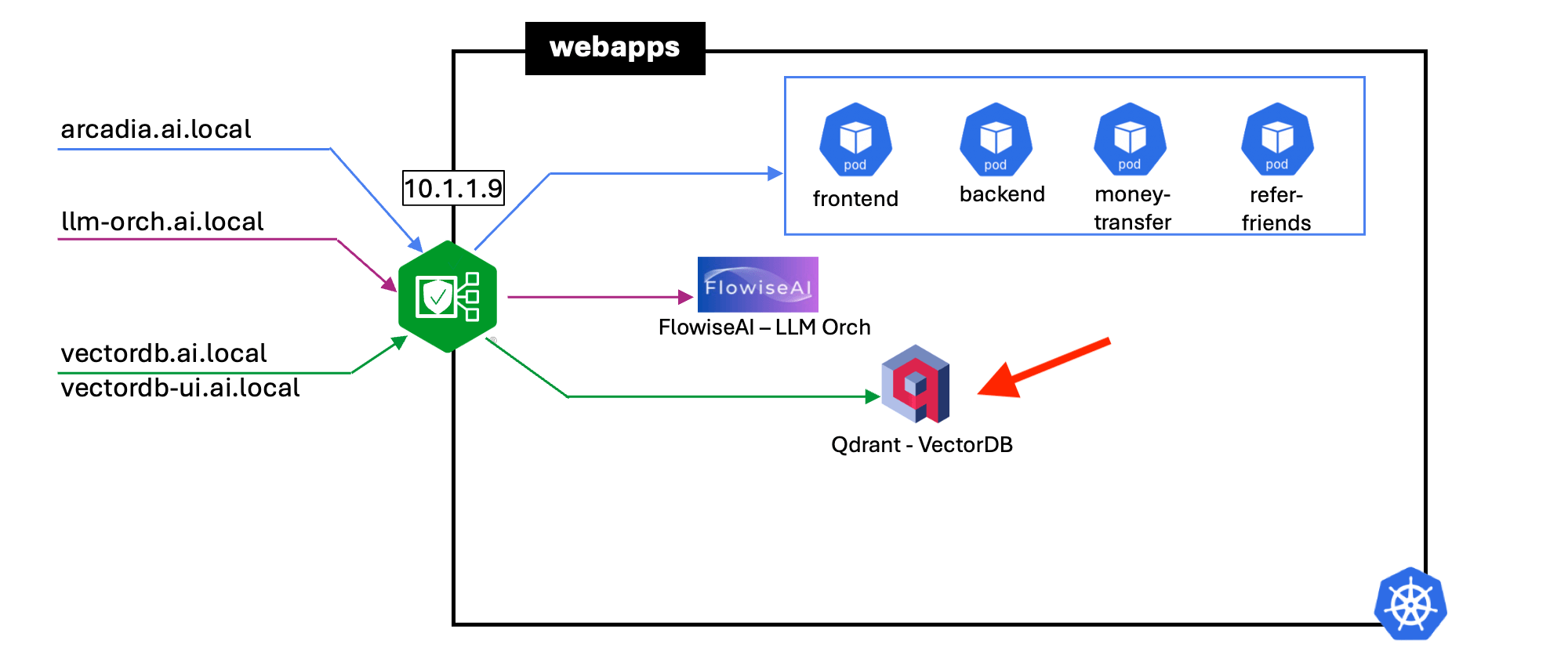
Qdrant is a vector similarity search engine and vector database. It provides a production-ready service with a convenient API to store, search, and manage vectors points.
cd ~/webapps/qdrant-helm
helm repo add qdrant https://qdrant.github.io/qdrant-helm
helm repo list
kubectl create ns qdrant
helm -n qdrant install qdrant --values values.yaml qdrant/qdrant
kubectl -n qdrant get po,svc
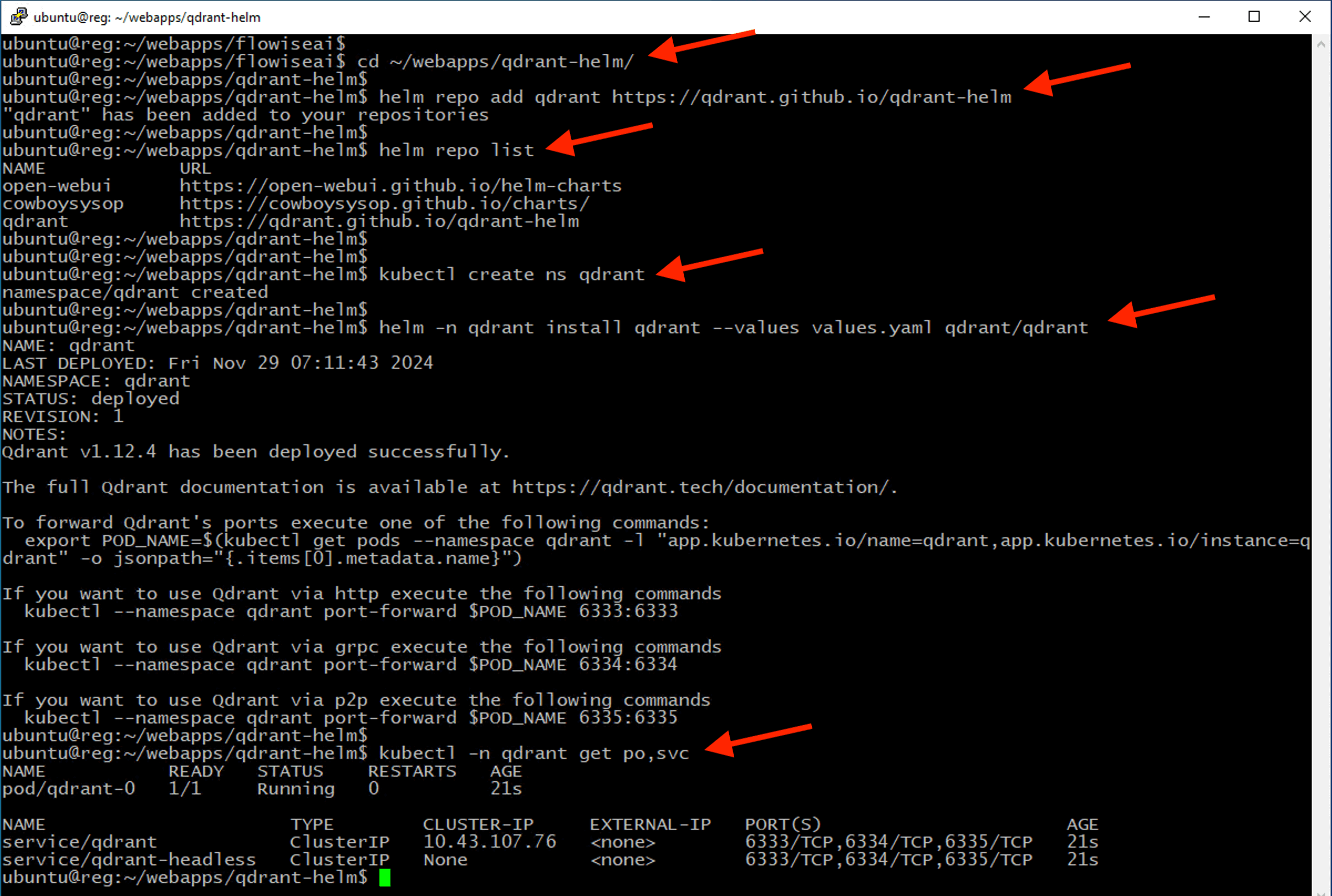
Note
Ensure all pods are in Running and READY state where all pods count ready before proceed.
Create an Nginx ingress resource to expose Qdrant VectorDB service externally from the Kubernetes cluster.
cd ~/webapps/qdrant-helm/nginx-ingress-qdrant
kubectl -n qdrant apply -f qdrant-ingress-http.yaml
kubectl -n qdrant apply -f qdrant-ingress-https-ui.yaml
kubectl -n qdrant get ingress

Confirm that you can login to Qdrant vector database
Attention
There is no authentication setup for qdrant console/dashboard. Hence, no login prompt. Its for lab and demo only. Ensure strong authentication is enforced in production environment.
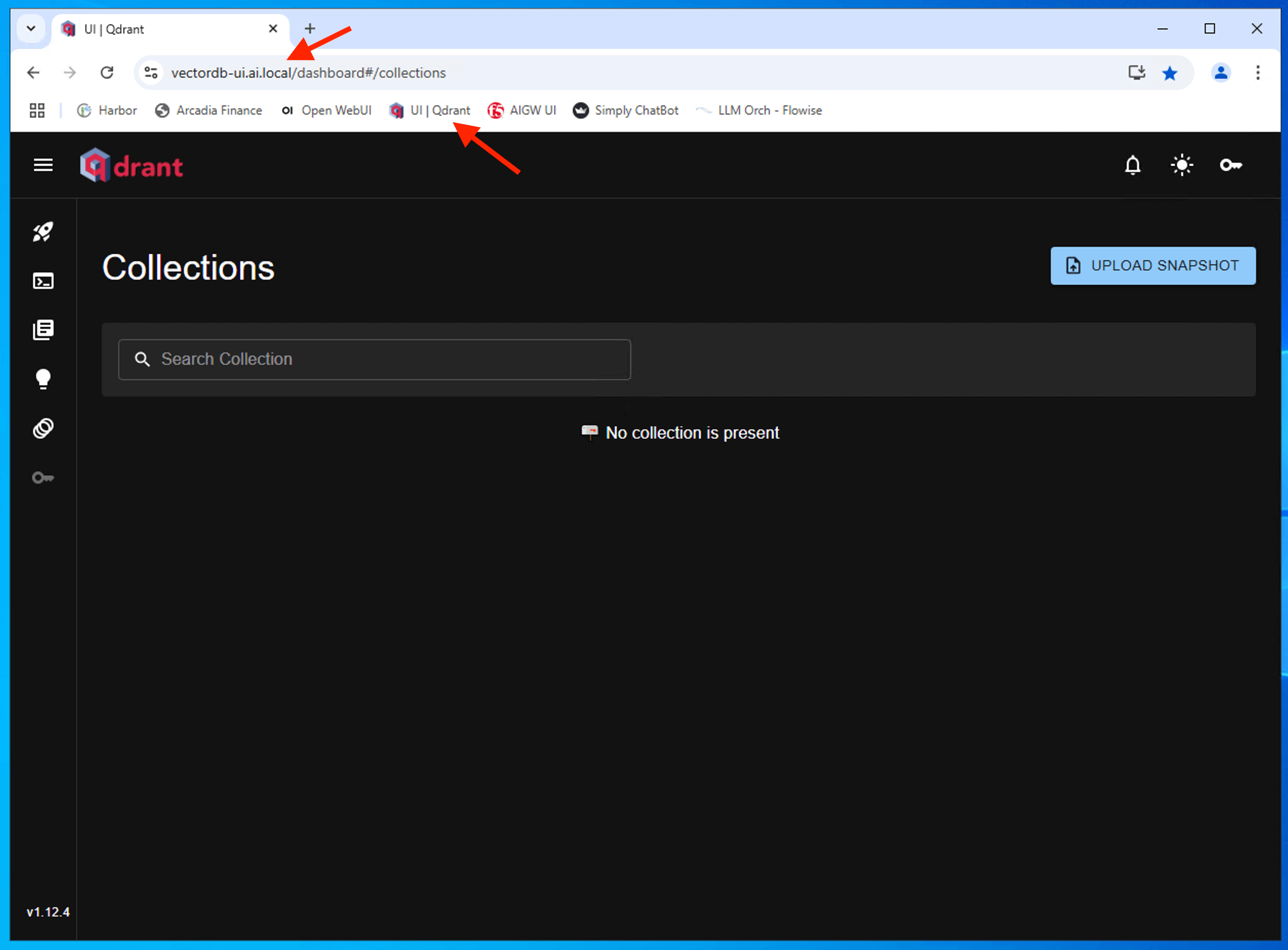
8 - Build RAG pipeline with FlowsieAI/Langchain¶
Load the imported “arcadia-rag” chatflow.
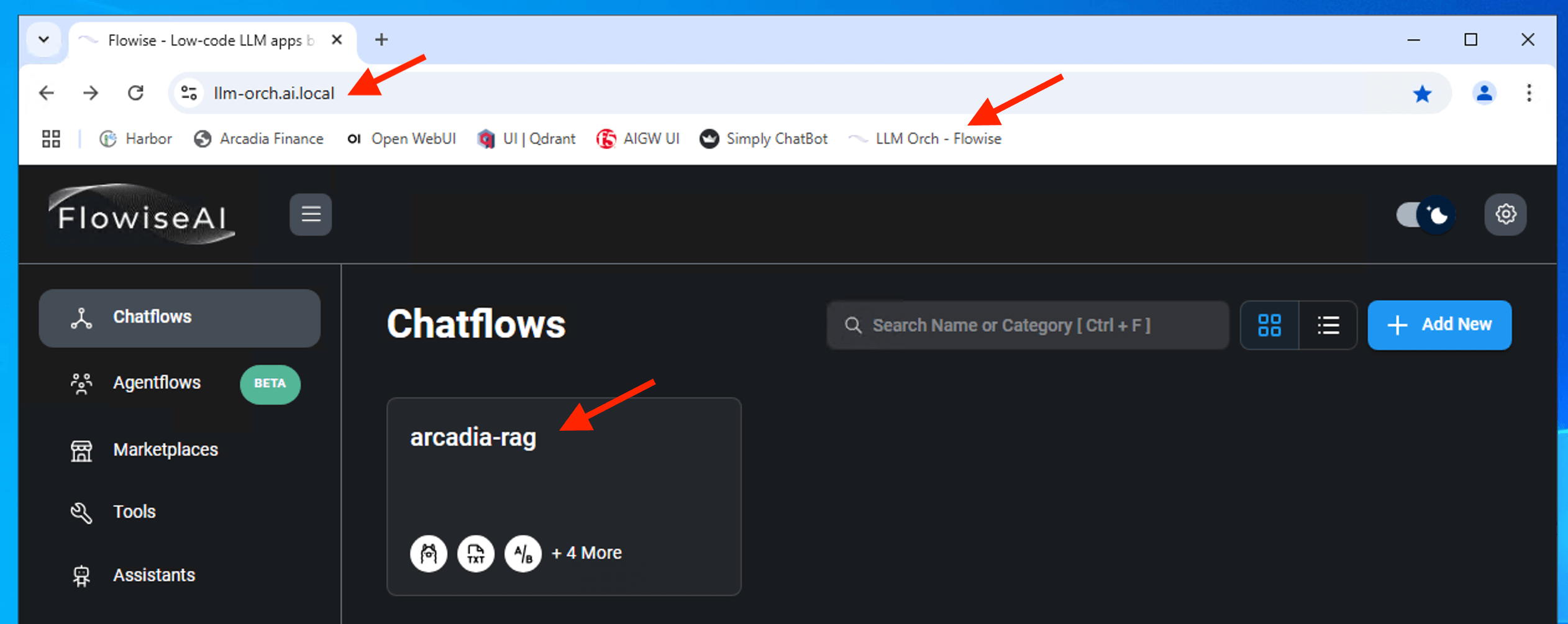
Here is the full RAG pipeline implemented in a low-code platform.
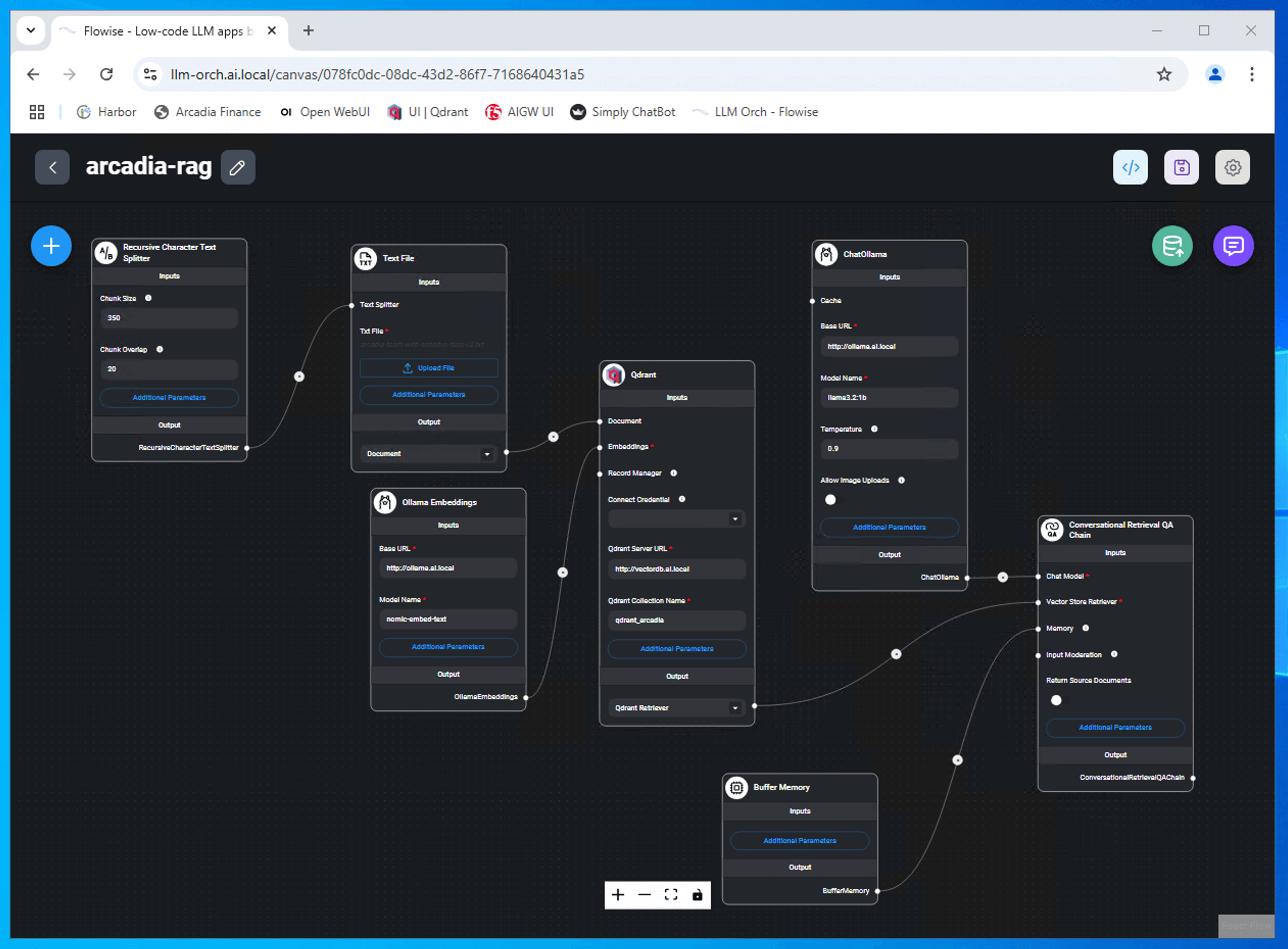
Here are some of the node/chain used.
| Node / Chain | Description |
|---|---|
Recursive Character Text Splitter
|
Split documents recursively by different characters - starting with “nn”, then “n”, then ” “. |
Text File Txt File:
|
Load data from text file This is the organization context information loaded and vectoried into vector database |
Ollama Embeddings Base URL: Model Name:
|
Generate embeddings for a given text using open source model on Ollama This is where chunk of text being sent to vectorized ollama.ai.local is an API endpoint where text will be send to convert text into vector arrays. |
Qdrant Qdrant Server URL: Qdrant Collection Name:
|
Qdrant vector database node. Node to define vector db locations, variable and collection name This is the API endpoint where vector array being stored and retrieved |
ChatOllama Base URL URL: Model Name:
Temperature:
|
A chat completion node for using LLM on Ollama. ollama.ai.local also the API inference endpoint llama3.2:1b will be use for the inference |
Conversational Retrieval QA Chat Model Vector Store Retriever Memory |
A chain for performing question-answering tasks with a retrieval component. Link all those node to the respective node |
| Buffer Memory | Use Flowise database table chat_message as the storage mechanism for storing/retrieving conversations. |
Vectorize Proprietary Data¶
RAG incorporate proprietary data to complement models and deliver more contextually aware AI outputs. However, in NLP (Neural Language Processing), AI don’t understand human language. Those texts or knowledge need to be converted into an understandable language by NLP where the process called embedding required to convert text into series of vector array.
nomic-embed-text is an embedding model that able to convert text into a vector array. In order for nomic-embed-text to work, the Qdrant dimension have to be updated to 768.
From Windows Jumphost, confirm the Qdrant Chain dimension is set to 768.
Click on Additional Parameter
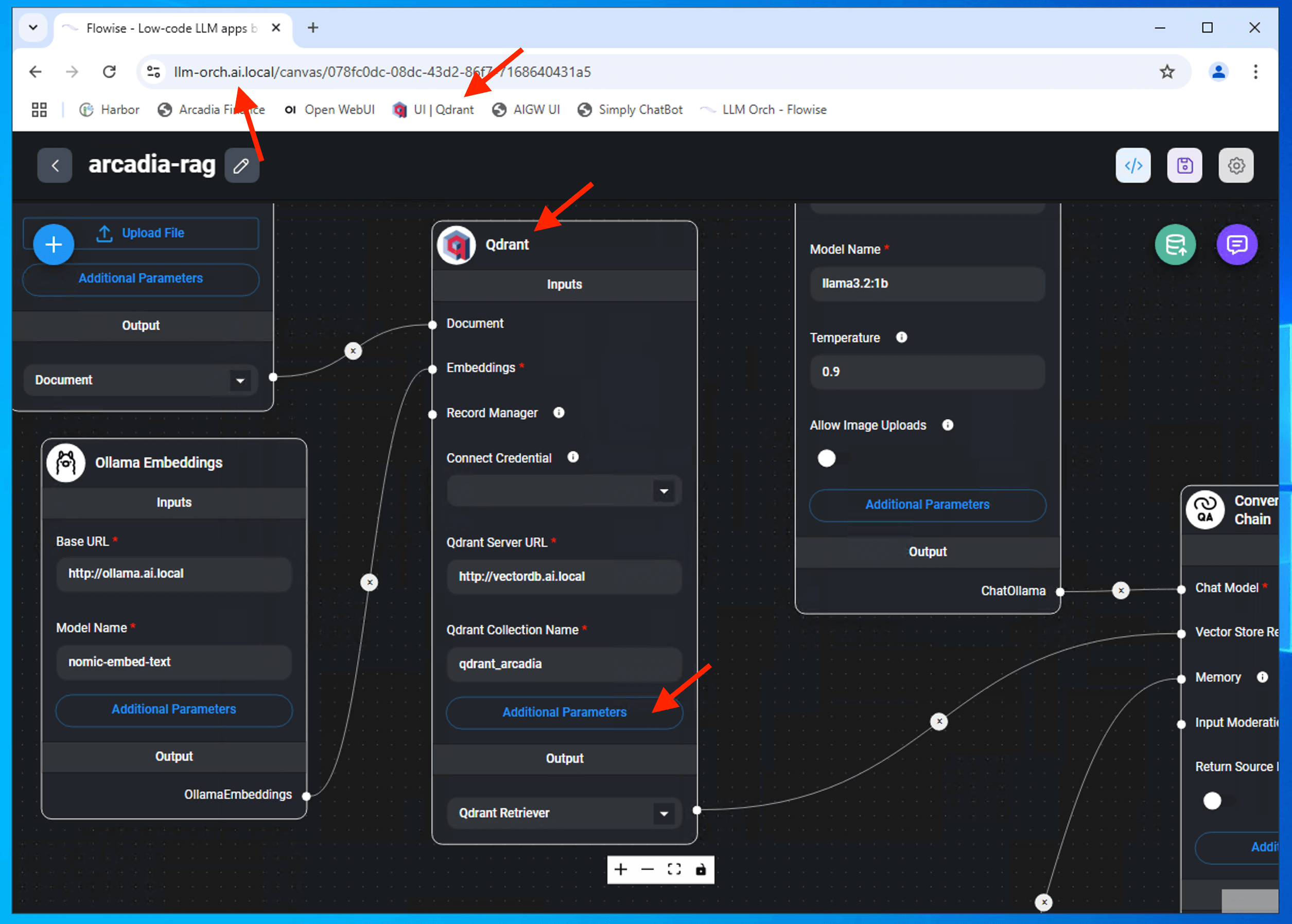
Ensure Vector Dimension is 768 and Similarity is Cosine
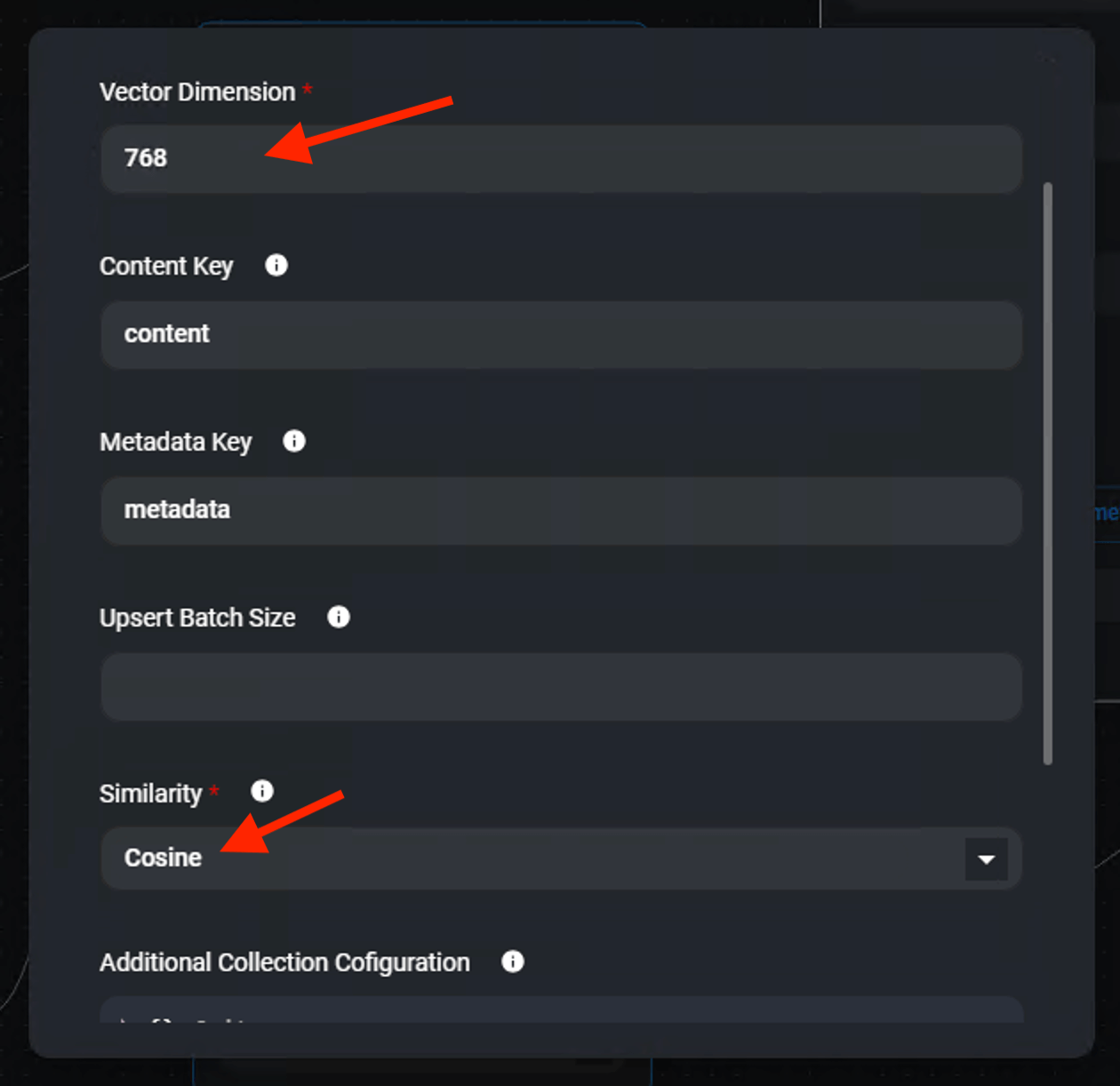
Note
Click anywhere outside to exit from the pop-up
Click Upsert Vector Database to performs the insert + update action on specified points
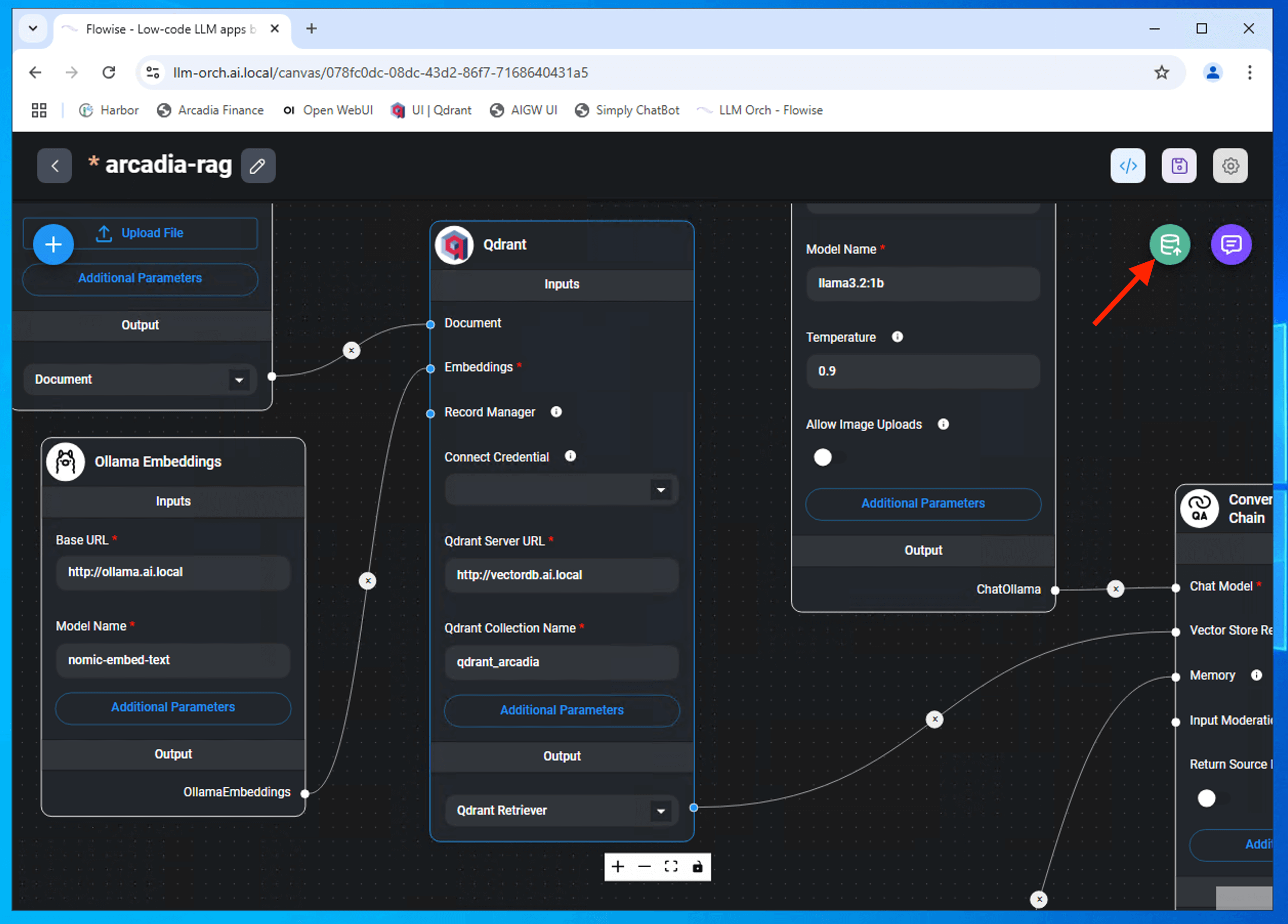
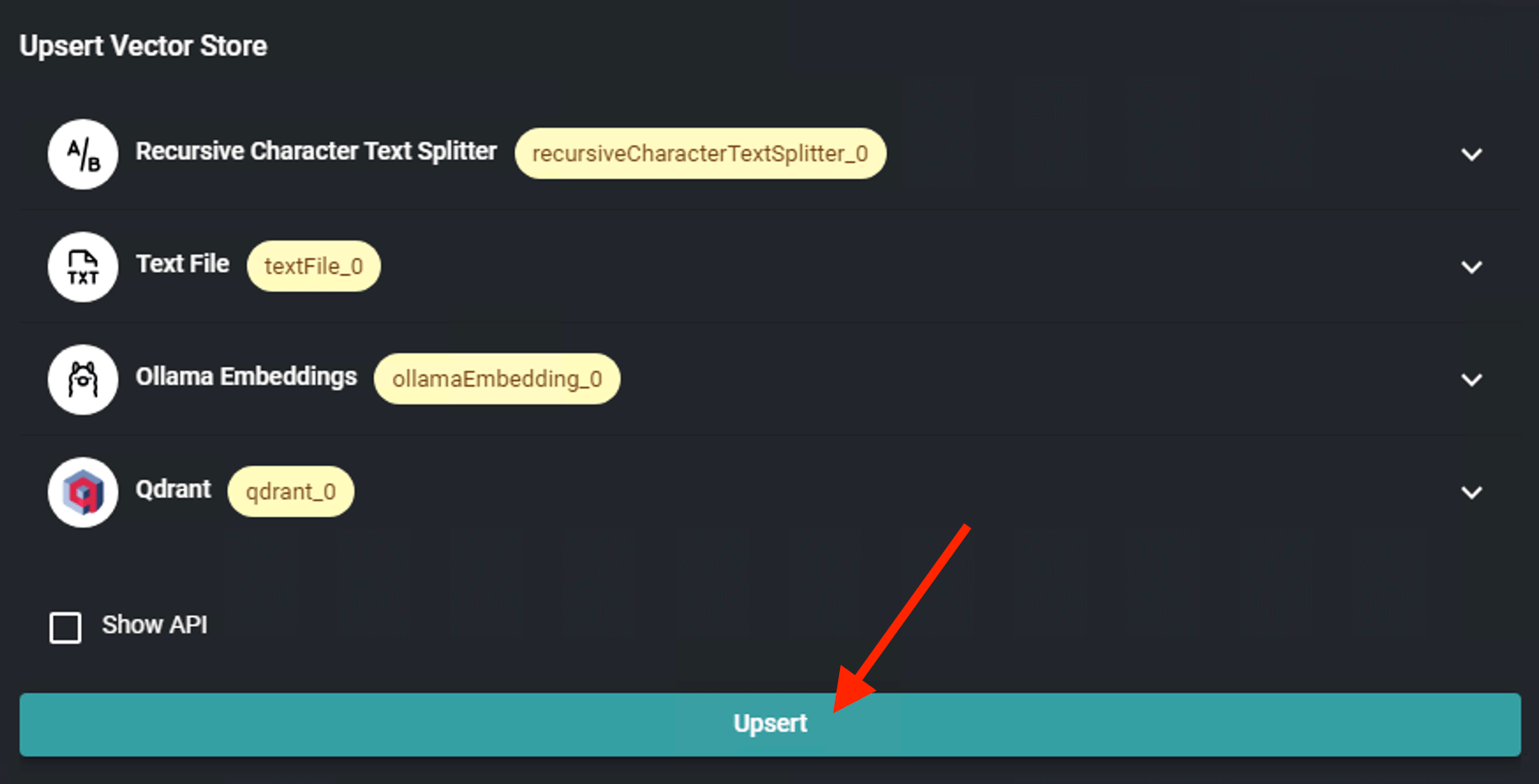
Successfully upsert vector store. Ensure you save the chatflow.
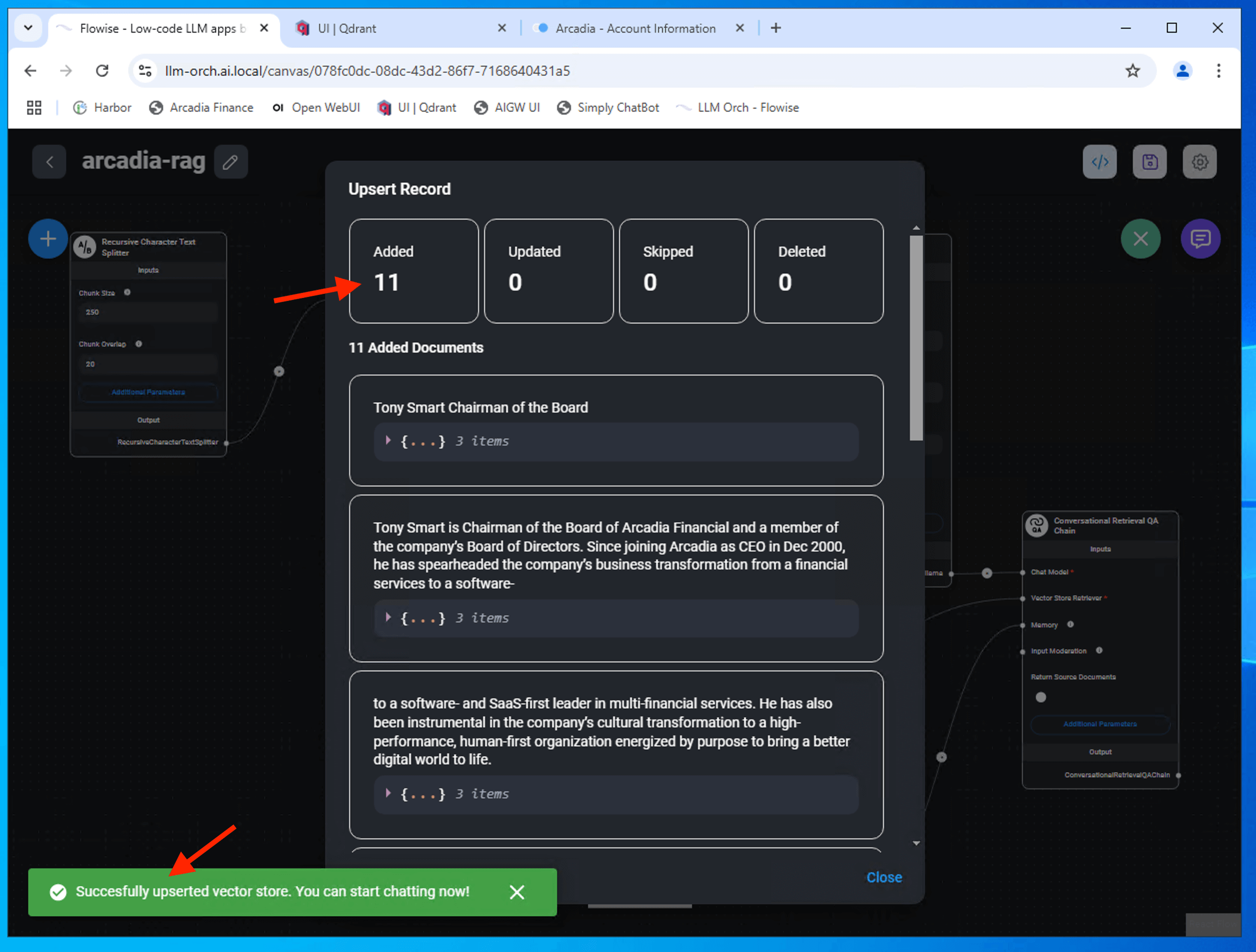
Login to Qdrant Dashboard to confirm vectordb created.
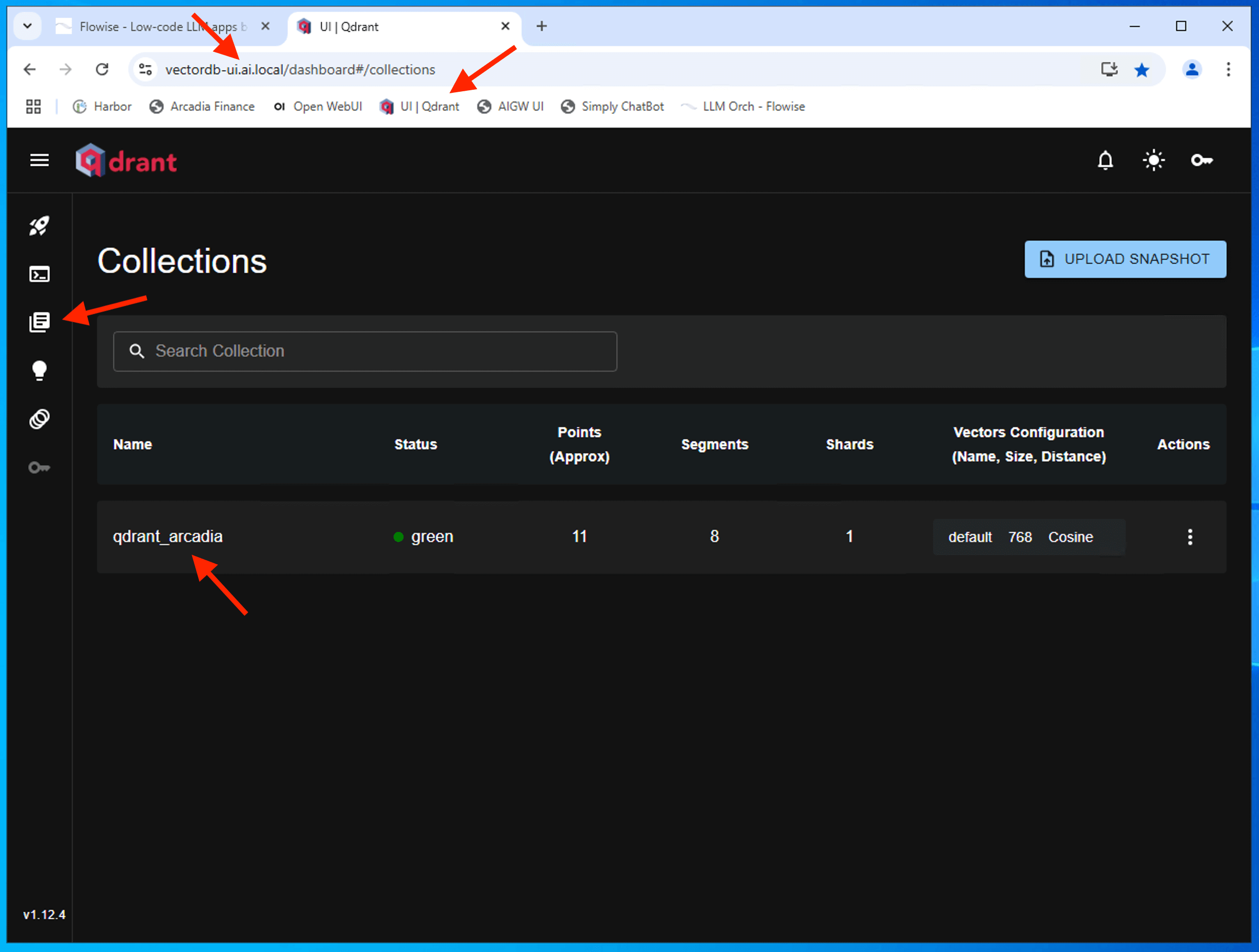
Validate your first GenAI RAG Chatbot¶
Click the Chat Icon
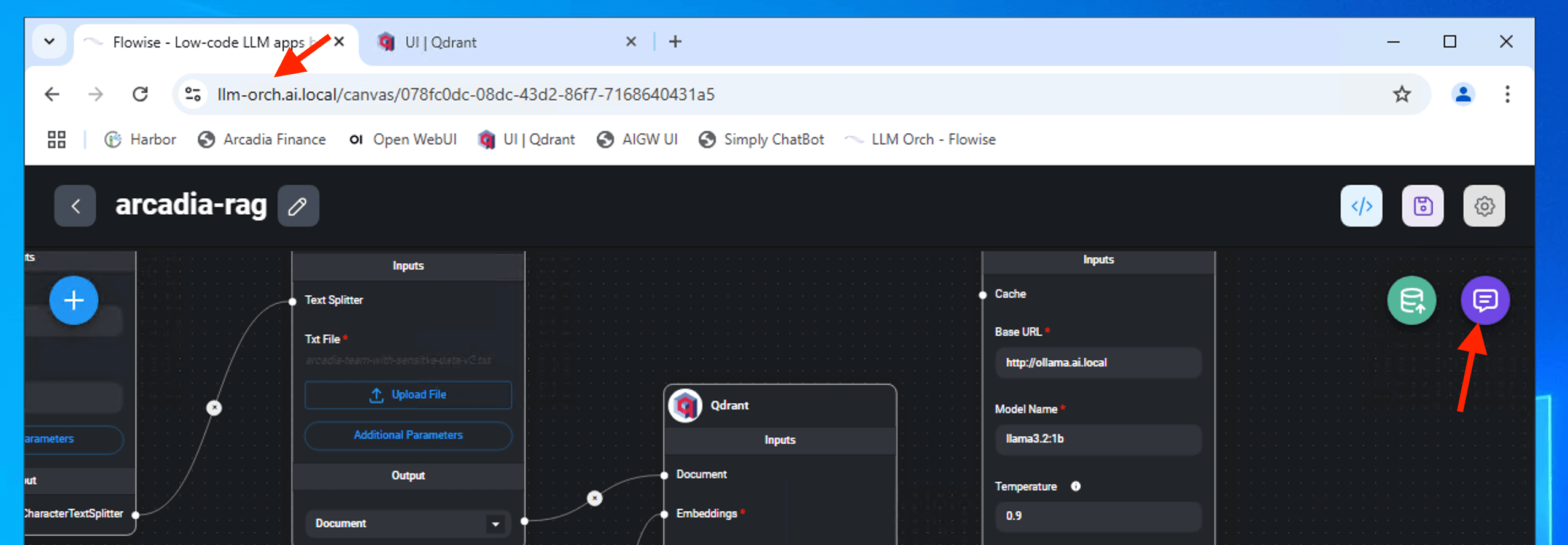
Input on the chat box
who is chairman of the board
Attention
You are using CPU for inference. Hence, expect some delay in the response.
Sample RAG Chatbot conversation
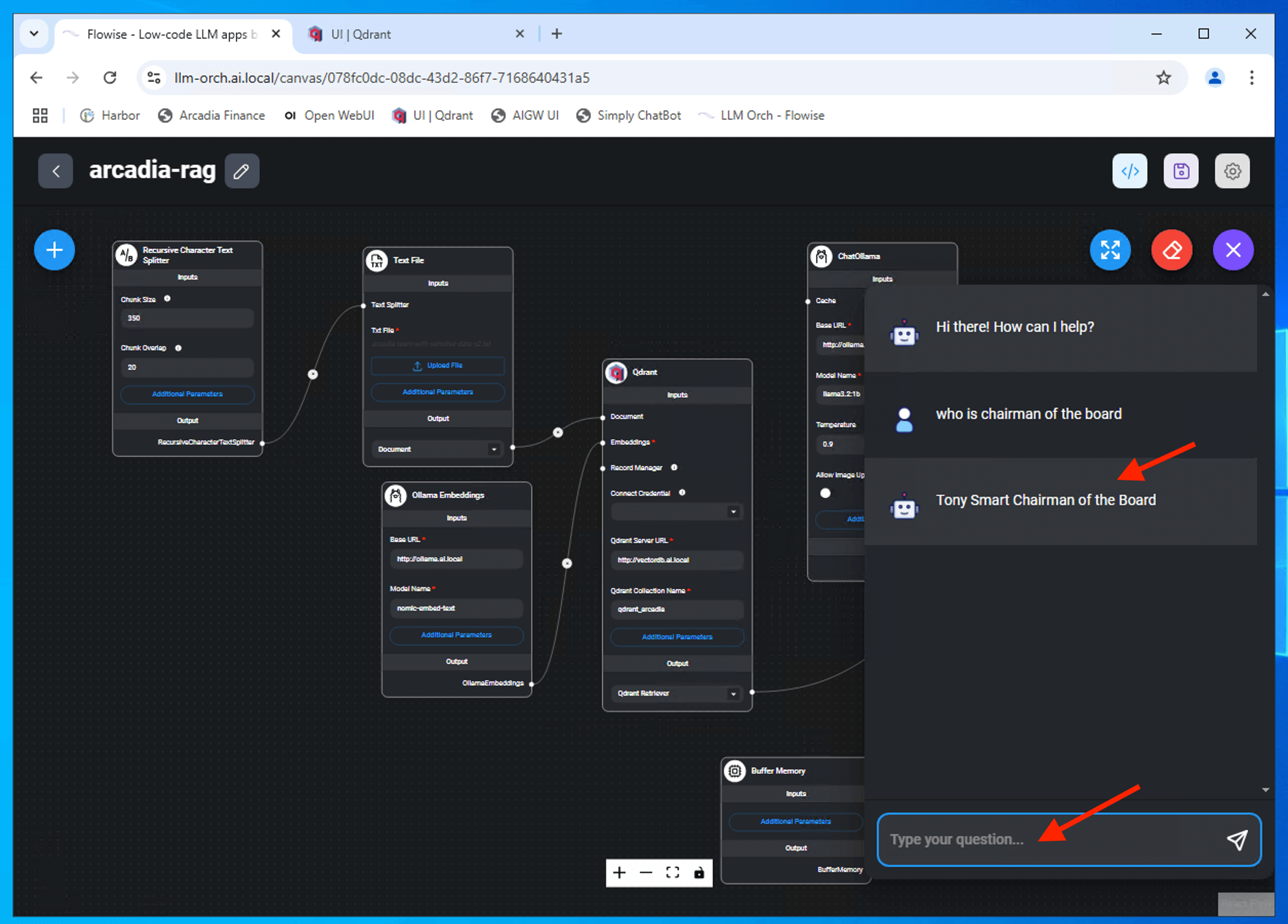
Suggested sample question ask to the RAG chatbot
give me all the name from the board of director
who is chris wong
tell me more about david strong
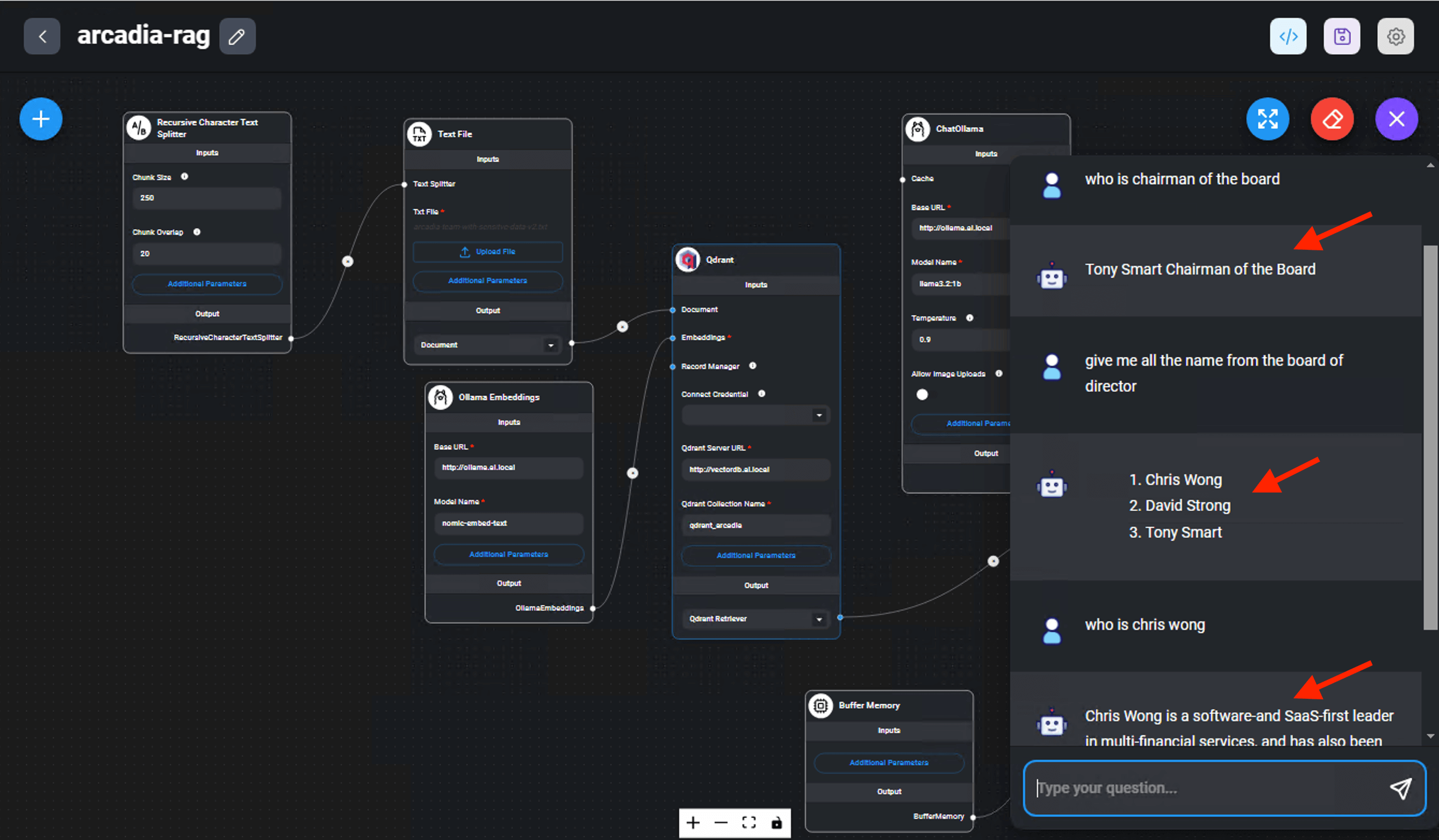
Source of inforamtion or “proprietary data” obtained from the text file store on Documents folder on the Windows jumphost.
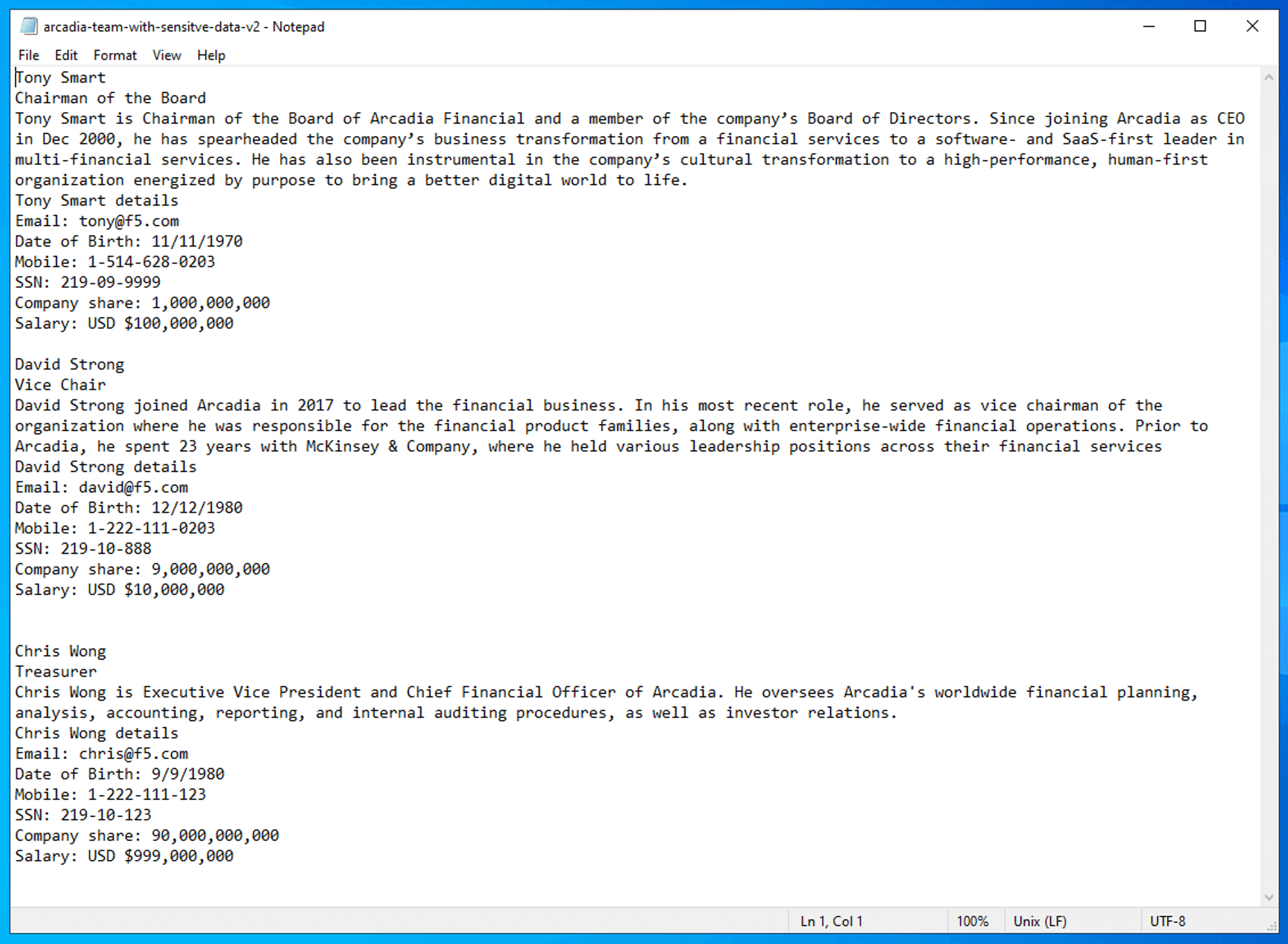
Attention
Generic Small Language Model (SLM) may not be as efficient compare to a Large Language Model (LLM) and may constantly encounter hallucination. You may modify the chunking size and chuking overlap to reduce hallucination. For the purpose of a lab, we are not expecting the model to provides an accurate and intelligent answer.
Attention
You may occasionally see document identifiers, such as “<doc id=’2’>,” appear in the response output. This issue can arise for several reasons, such as inadequate post-processing where metadata is not properly cleaned or removed, or during pre-processing when data is tagged with metadata that the model interprets as legitimate text. In this particular lab, the issue is likely due to a combination of factors, including the inference and embedding model’s behavior and the use of a CPU for processing.
You have successfully build a GenAI RAG Chatbot
